A Minimum Cost Design Approach for Steel Frames Based on a Parallelized Firefly Algorithm and Parameter Control
Abstract
:1. Introduction
2. Optimum Design Problem
2.1. General Optimal Design Problem
- There are a large number of variables (1) and large scales (XvU − XvL) (4), creating an extensive design space.
- The variables are discrete or a mixture of continuous/discrete variables.
- The objective function (2) is non-linear, and the constraints (3) are many and non-linear. Cases in which derivatives of the objective function and the constraints appear at some point in the design space with values close to zero (functions insensitive to variables) or very high (jumps) are especially difficult to solve.
2.2. The Firefly Algorithm
- A firefly’s brightness is inversely proportional to the fitness function, so the firefly in the population with the lowest fitness function value (lowest cost and fewest constraint violations) shines brighter than the rest of the population. Fireflies are ordered by their brightness from the brightest to the dimmest in the population.
- Fireflies have no gender, so any one can be attracted to another in the population. The attraction between two fireflies, i and j, in the population decreases with the distance between them. The dimmer firefly i moves toward the brighter one j. The attraction between them is defined as
2.3. Variables
2.4. Fitness Function
2.5. Constraints
2.5.1. Story Lateral Sway Constraints
2.5.2. Beam Deflection Constraints
2.5.3. Slenderness Constraints
2.5.4. Buckling Constraints
- for Class 1 and Class 2 cross-sections
- for Class 3 cross-sections
- for Class 4 cross-sections
2.5.5. Strength Constraints
- for Class 1 and Class 2 cross-sections
- for Class 3 cross-sections
- for Class 4 cross-sections
2.5.6. Semi-Rigid Connection Strength Constraints
2.5.7. Semi-Rigid Connection Assembly Constraints
3. Optimization Methodology
3.1. Parallel Firefly Algorithm with Migration (PFAM)
- The population is divided into subpopulations that extend the search throughout the design space. This division into subpopulations favors finding local optima in the exploration phase. From among all the local optima found, the best local optimum is selected at the end of the process in the exploitation phase. This becomes a candidate for the global optimum, as previously mentioned [9]. Dividing the population into subpopulations also makes it easier to parallelize the algorithm [23]. A MATLAB® code has been defined to implement this parallel strategy using the MATLAB® parfor command.
- A firefly’s brightness is inversely proportional to the fitness function, so the firefly in the subpopulation with the lowest fitness function value (lowest cost and fewest constraint violations) shines brighter than the rest of the subpopulation. Fireflies are ordered by their brightness from the brightest to the dimmest in each subpopulation.
- Fireflies have no gender, so any one can be attracted to another in a subpopulation. The position of a firefly i in a subpopulation, which is attracted to another, brighter firefly j in the same subpopulation, is obtained using the following expression
- iv.
- Some fireflies from the subpopulation containing the brightest firefly of all the subpopulations (origin subpopulation) are randomly selected and sent to other randomly selected subpopulations. This process of migration allows the fireflies to share information. As the origin subpopulation is the one yielding information, there is a risk that the search for the other subpopulations might be conditioned to include the local optimum. This can result in a biased search, with the search for local optima favored over a global optimum. To reduce this potential bias, a simple strategy consisting of perturbing the best design in the origin population and in each subpopulation has been included in the algorithm [23]. Therefore, if these best designs in each subpopulation are local optima, the perturbation eliminates this status, at least during the next iteration. The perturbation of the brightest firefly (i = 1) in a subpopulation is defined using the following expression:
3.2. Parameter Tuning in PFAM
- configuring an algorithm by choosing parameter values that optimize its performance; or
- analyzing an algorithm by studying how its performance depends on the values of its parameters.
- iii.
- analyzing an algorithm to see how its performance varies when different problems are considered; and
- iv.
- analyzing an algorithm to see how its performance changes when it is executed several times independently.
3.3. Parameter Control in PFAM
4. Examples
4.1. Three-Bay Two-Story Framework
4.1.1. Parameter Tuning in PFAM for the Three-Bay Two-Story Framework
- Accuracy, calculated as the ratio between the cost of the optimal design solution (Table 3) and the mean value of the cost obtained from the independent executions, which measures the efficiency of the algorithm; and
- Standard Deviation of the cost obtained from the independent executions, which measures the dispersion or robustness of the results obtained using the algorithm.
- (i)
- the selected values of parameters nt = 250 and kmax = 100 produced good metric results with low computational cost;
- (ii)
- parameter tc affected the exploration and exploitation phases of the algorithm, obtaining good metric values when its values were reduced to around tc = 0.1;
- (iii)
- the values of m close to the unit produced good metric values for low values of tc; and
- (iv)
- the values of parameter γ0 greater than the unit produced good metric values regardless of the parameter α0 value adopted.
- First sensitivity analysis: with rigid connections and constant values β0 = 1, nt = 30, kmax = 100, tc = 0.3, and m = 2, the values of the α0 and γ0 parameters were modified. As previously carried out, and because it was the first sensitivity calculation performed with parameters α0 and γ0, wide ranges of both parameters were considered. The accuracy results are shown in Table 20, and the standard deviation results are shown in Table 21.
| γ0 | Mean | ||||||||
|---|---|---|---|---|---|---|---|---|---|
| 0.1 | 1 | 10 | 25 | 50 | 75 | 100 | |||
| α0 | 0.3 | 1.000000 | 0.946488 | 0.992191 | 0.910663 | 0.891969 | 0.758022 | 0.668462 | 0.881113 |
| 0.4 | 1.000000 | 0.967716 | 0.993883 | 0.882127 | 0.832489 | 0.786748 | 0.786933 | 0.892842 | |
| 0.5 | 1.000000 | 0.971335 | 0.992453 | 0.943934 | 0.753382 | 0.838944 | 0.921210 | 0.917323 | |
| 0.6 | 0.971560 | 0.952837 | 0.898089 | 0.844372 | 0.708637 | 0.773464 | 0.598494 | 0.821065 | |
| 0.7 | 0.997763 | 0.993318 | 0.933460 | 0.909359 | 0.779504 | 0.788907 | 0.662411 | 0.866389 | |
| 0.8 | 0.997763 | 0.973706 | 0.922725 | 0.923220 | 0.887281 | 0.861669 | 0.754091 | 0.902922 | |
| 0.9 | 0.970565 | 0.966832 | 0.956470 | 0.974998 | 0.883387 | 0.700241 | 0.827291 | 0.897112 | |
| 1.0 | 0.939673 | 0.952912 | 0.955308 | 0.911318 | 0.808622 | 0.770159 | 0.680694 | 0.859812 | |
| mean | 0.984665 | 0.965643 | 0.955572 | 0.912499 | 0.818159 | 0.784769 | 0.737448 | ||
| γ0 | Mean | ||||||||
|---|---|---|---|---|---|---|---|---|---|
| 0.1 | 1 | 10 | 25 | 50 | 75 | 100 | |||
| α0 | 0.3 | 0.00 | 1128.45 | 131.15 | 1532.62 | 1684.33 | 2990.43 | 3459.81 | 1560.97 |
| 0.4 | 0.00 | 868.15 | 94.18 | 1763.05 | 2588.30 | 4499.15 | 3664.25 | 1925.30 | |
| 0.5 | 0.00 | 761.60 | 97.77 | 1141.50 | 3045.85 | 2183.85 | 638.44 | 1124.15 | |
| 0.6 | 749.05 | 1244.95 | 2289.27 | 3165.81 | 4131.11 | 2993.27 | 5184.88 | 2822.62 | |
| 0.7 | 62.20 | 101.90 | 1747.11 | 1915.66 | 3609.77 | 2567.04 | 4039.21 | 2006.13 | |
| 0.8 | 62.20 | 686.37 | 2161.60 | 1170.22 | 1555.39 | 1829.78 | 3129.82 | 1513.62 | |
| 0.9 | 683.55 | 856.40 | 1024.49 | 231.44 | 1627.07 | 3962.12 | 2520.01 | 1557.87 | |
| 1.0 | 1491.07 | 1062.74 | 849.50 | 1365.04 | 2745.92 | 3131.86 | 3486.90 | 2019.00 | |
| mean | 381.01 | 838.82 | 1049.38 | 1535.67 | 2623.47 | 3019.69 | 3265.41 | ||
- ii.
- Second sensitivity analysis: with rigid connections and constant values β0 = 1, nt = 30, kmax = 100, tc = 0.1, and m = 4, the values of the α0 and γ0 parameters were modified. As previously carried out, wide ranges of parameters α0 and γ0 were considered. The accuracy results are shown in Table 22, and the standard deviation results are shown in Table 23.
4.1.2. Parameter Control for the Three-Bay Two-Story Framework
4.2. Three-Bay Ten-Story Framework
4.2.1. Parameter Tuning in PFAM for the Three-Bay Ten-Story Framework
- (i)
- the selected values of parameters nt = 1000 and kmax = 100 produced good metric results with low computational cost;
- (ii)
- parameter tc affected the exploration and exploitation phases of the algorithm, obtaining good metric values when values of parameter tc of around 0.1 were adopted;
- (iii)
- m values close to the unit produced good metric values for low tc values; and
- (iv)
- the values of parameter γ0 greater than the unit produced good metric values, with α0 in the range [0.3, 1.0].
4.2.2. Parameter Control for the Three-Bay Ten-Story Framework
4.3. Analysis and Discussion of the Results
5. Conclusions
- The sensitivity of the PFAM algorithm is higher for changes in parameters tc, γ0, and nt than for changes in parameters α0, m, and kmax.
- As expected, a close dependence between parameters tc, α0, γ0, and m has been detected. Changes in the value of one produce changes in the optimal tuned values of the rest of them.
- The optimal tuned values of the parameters are different when considering EEP2 semi-rigid connections (SRC) or rigid connections (RC). The optimal tuned values somewhat affected are those related to parameters tc (SRC: [0.1, 0.3]; RC: [0.1, 0.5]), α0 (SRC: [0.3, 1.0]; RC: [0.3, 0.5]), γ0 (SRC: [10, 25]; RC: [0.1, 25]), and m (SRC: [1, 2]; RC: [1, 3]). The most affected optimal tuned values are those related to parameter nt (SRC: [250, 1000]; RC: [30, 450]).
- If the intersection between the above somewhat affected optimal tuned values is considered, it is concluded that the optimal tuned values are the following: tc ⸦ [0.1, 0.3]; α0 ⸦ [0.3, 0.5]; γ0 ⸦ [10, 25]; and m ⸦ [1, 2].
- The value of parameter kmax = 100 produces quite satisfactory results with a lower computational cost in all the cases considered.
- The sensitivity study does not allow an interval of optimal tuned values for the parameter nt independent of the problem to be determined.
- Considering different cases with constant values of some parameters, β0 = 1, kmax = 100, tc = 0.1, α0 = 1.0, and m = 2, all of them non-optimal and with a range of values for γ of the interval [1, 50], the PCPFAM procedure produces results as satisfactory as those obtained with the PFAM procedure and with optimal tuned values of the parameters. The fact that parameter γ varies in the interval [1, 50], maximizing the fitness landscape, compensates for not choosing optimal tuned values of other parameters, which makes PCPFAM more robust than PFAM.
- PCPFAM can only act on parameters β0, α, γ, and m, which may change during the design process, but not on parameters tc, nt, and kmax, which remain constant. Among the latter, nt is the one that most affects the algorithm’s performance. Therefore, PCPFAM cannot eliminate the uncertainty in the choice of parameter nt.
- The optimal tuned values of the nt parameter (minpop), found in the sensitivity analysis with PFAM, were very different and depended greatly on the case considered. The study was able to determine that parameter nt depends mainly on the number of variables nv considered in each case.
- Once the dependence of parameter nt, with respect to the number of variables nv, was detected, a Least-Square regression adjustment was made with the optimal tuned values minpop of parameter nt and the number of variables nv. A simple expression, which is easy to remember, removes the uncertainty for nt, giving it a value (estminpop) that is a function of the number of variables nv in the problem.
Author Contributions
Funding
Data Availability Statement
Conflicts of Interest
Appendix A
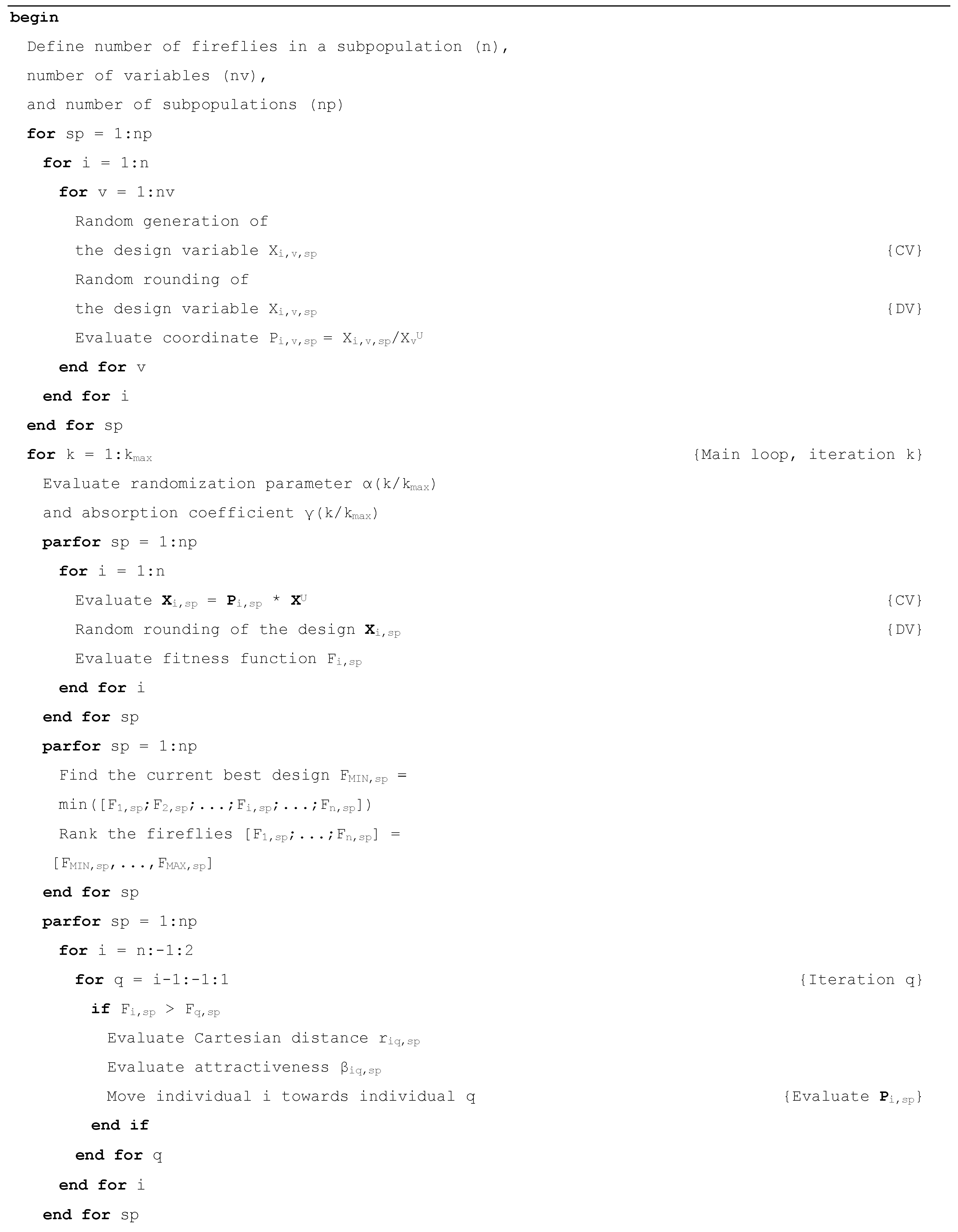
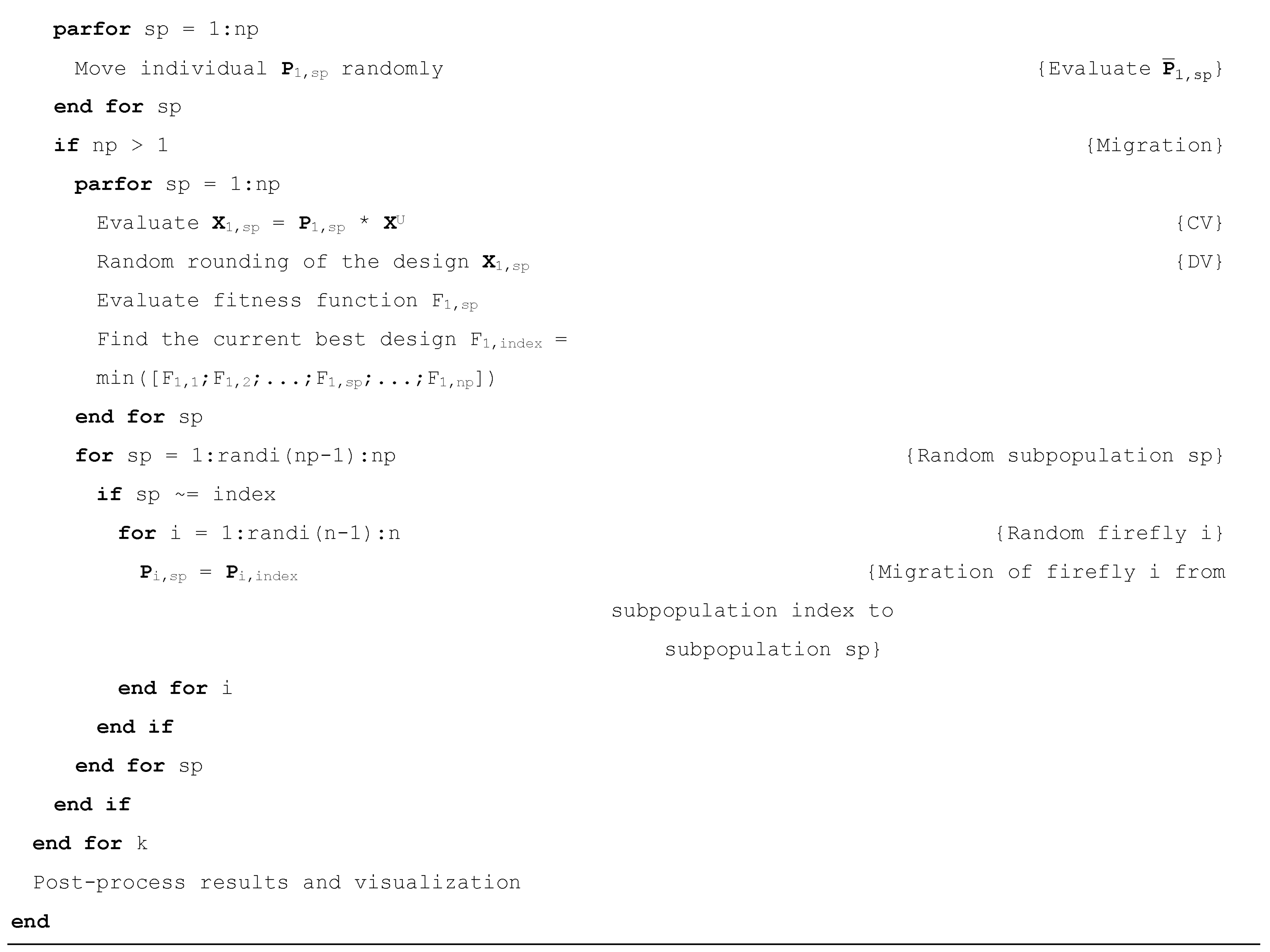
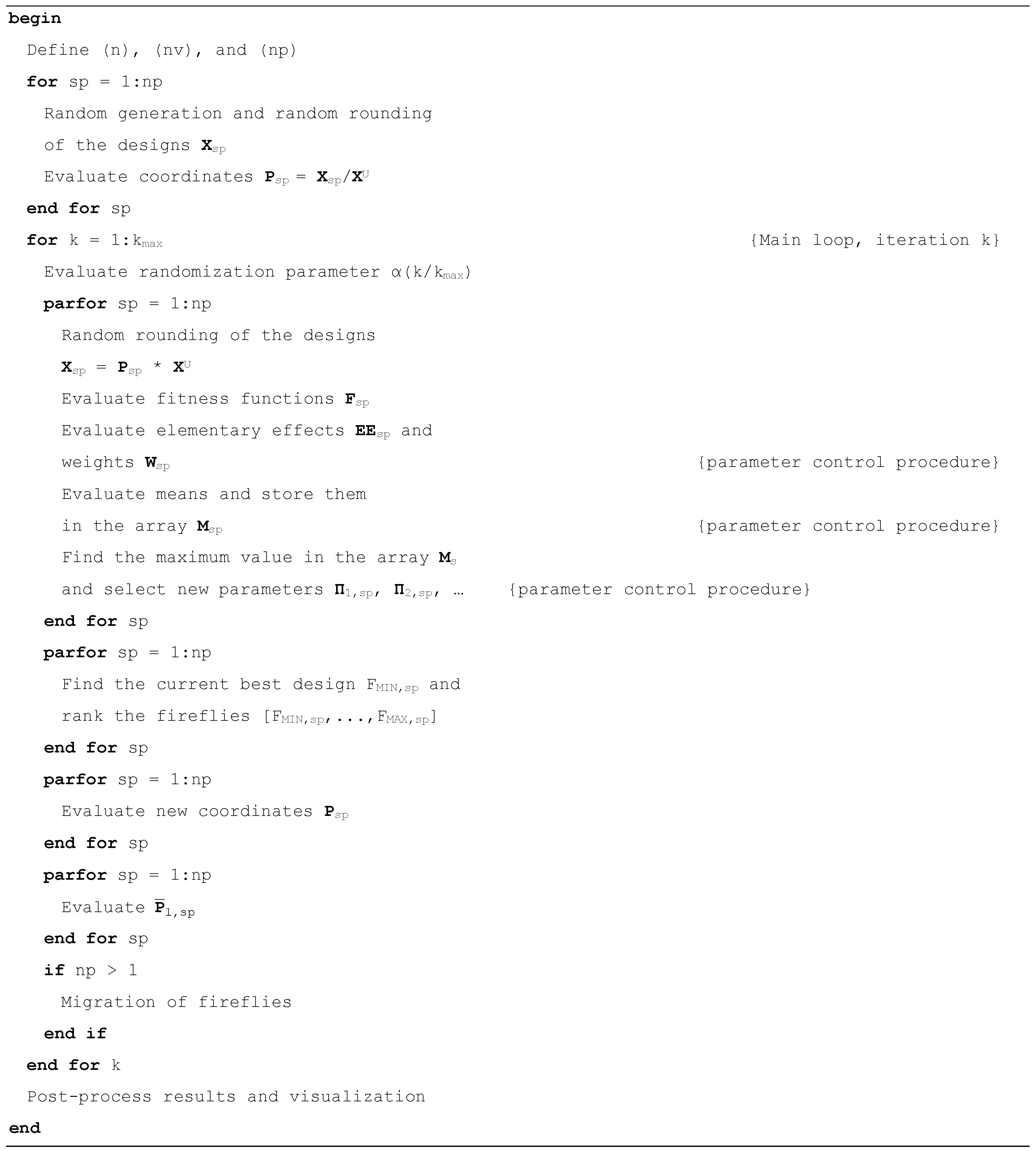

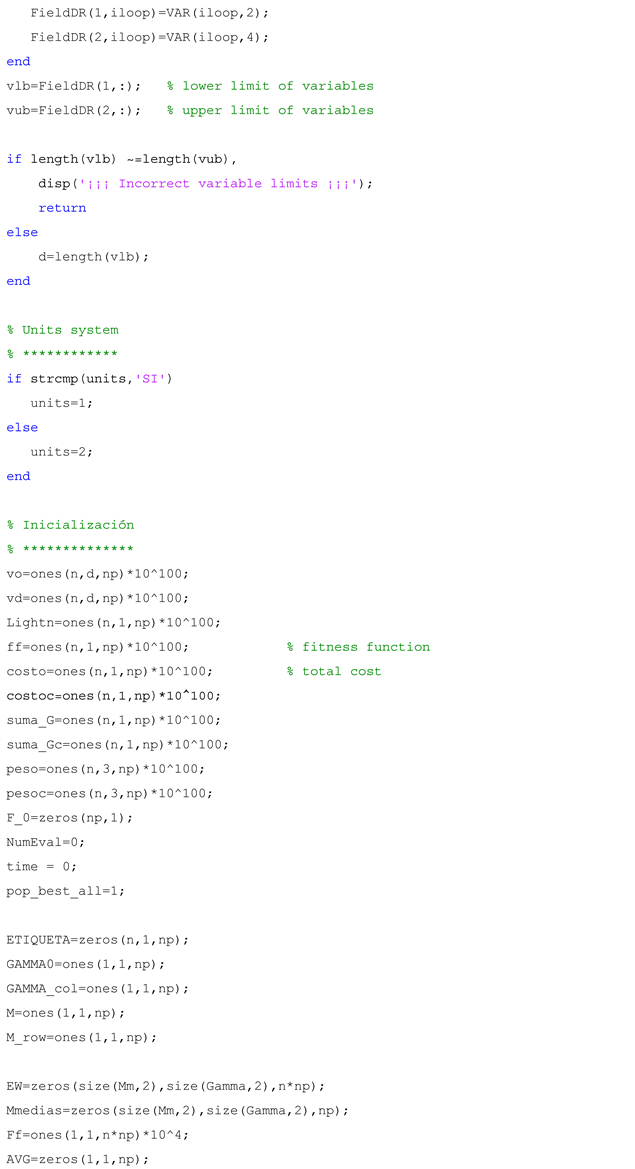
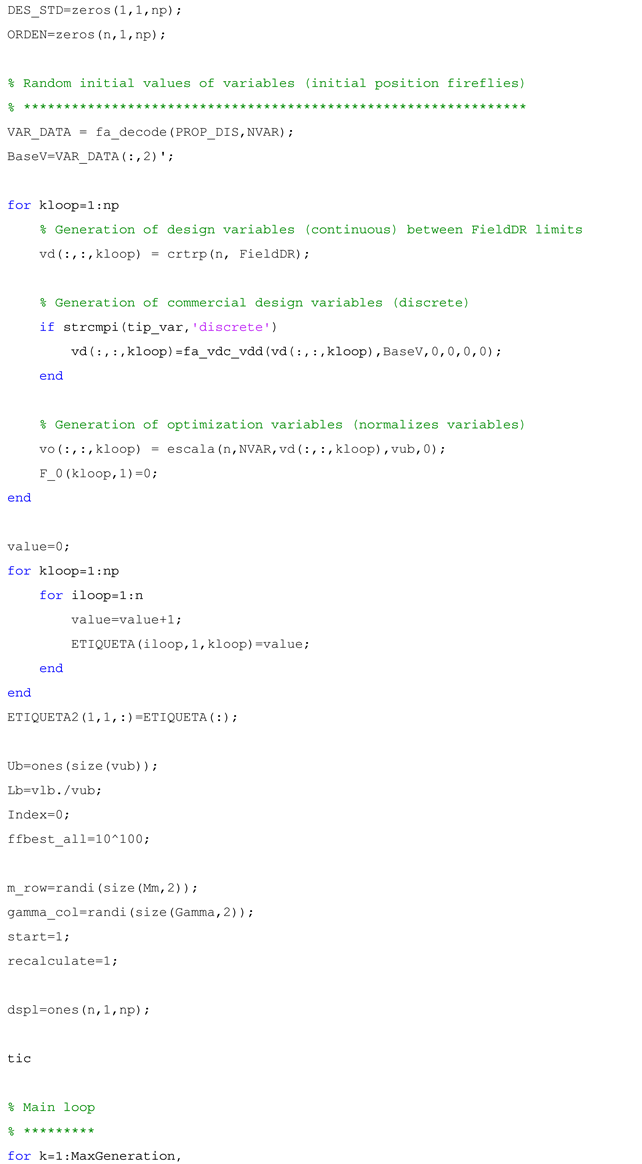


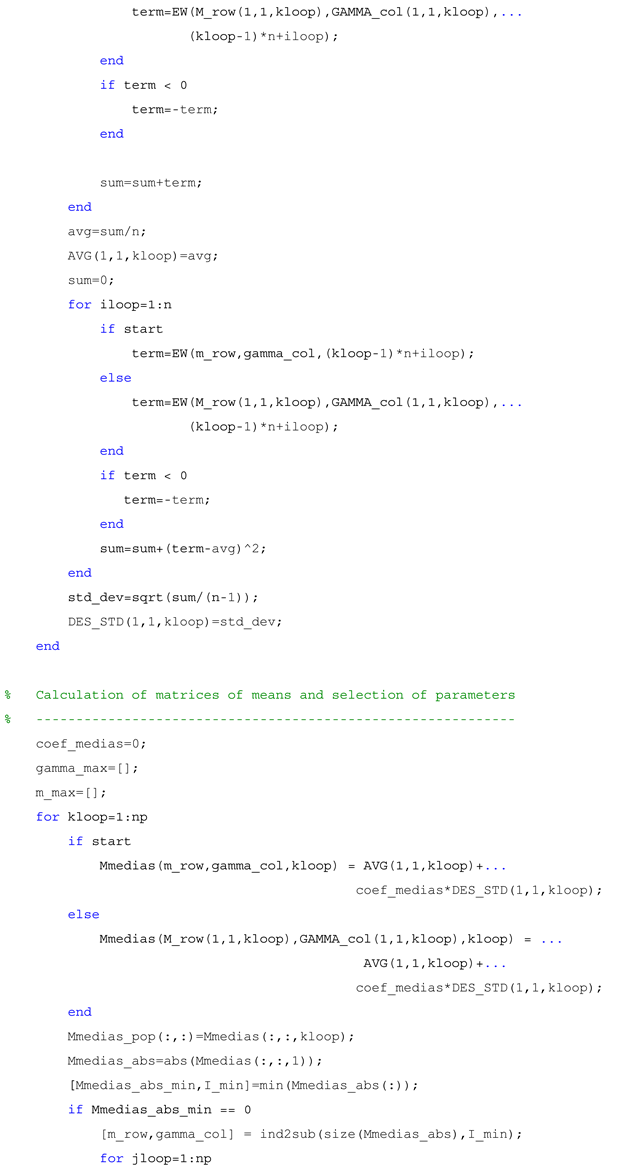

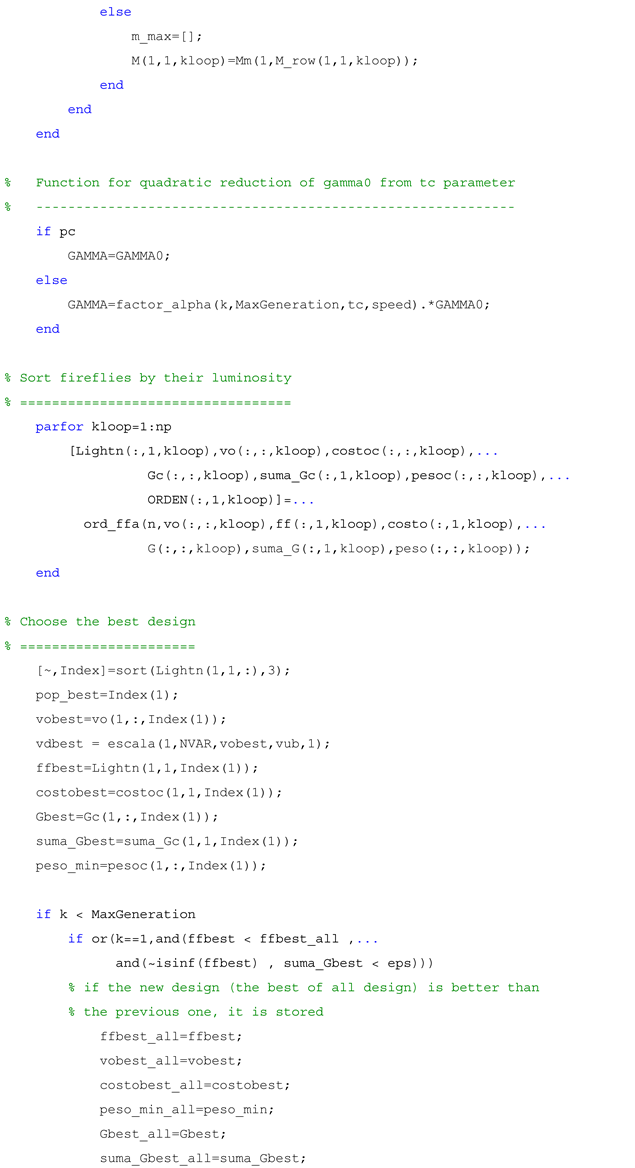

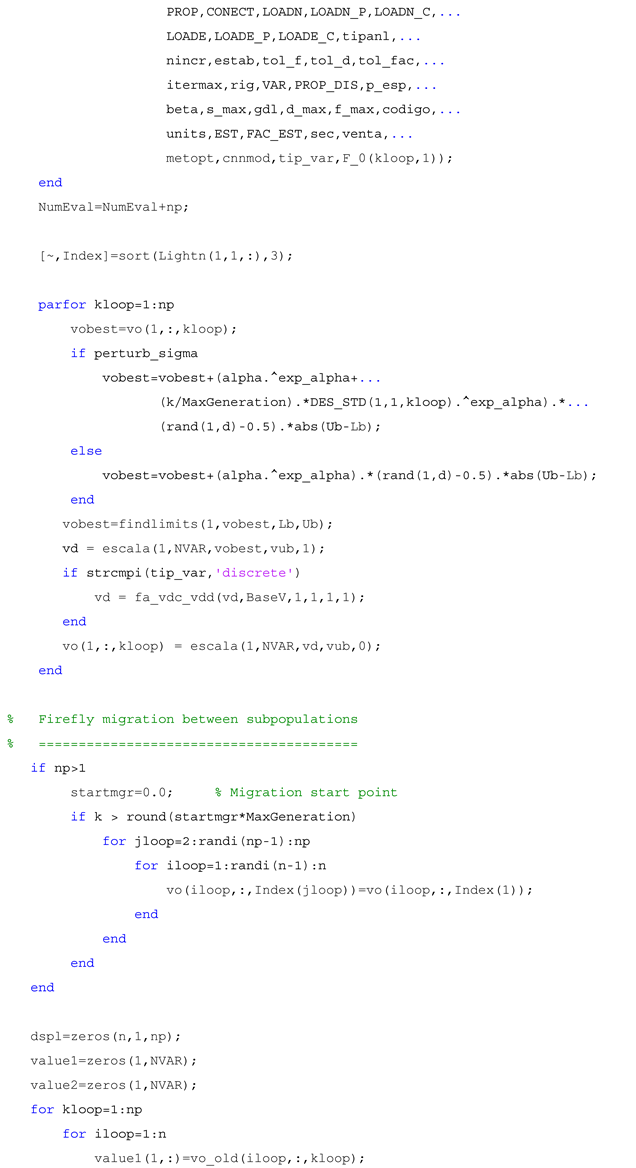


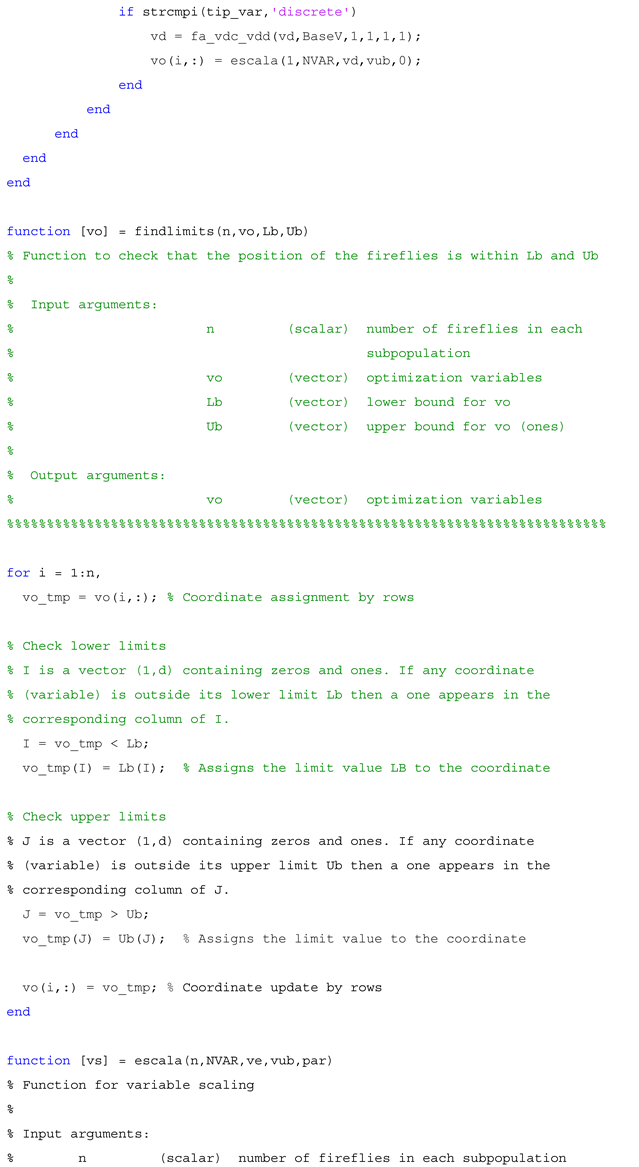
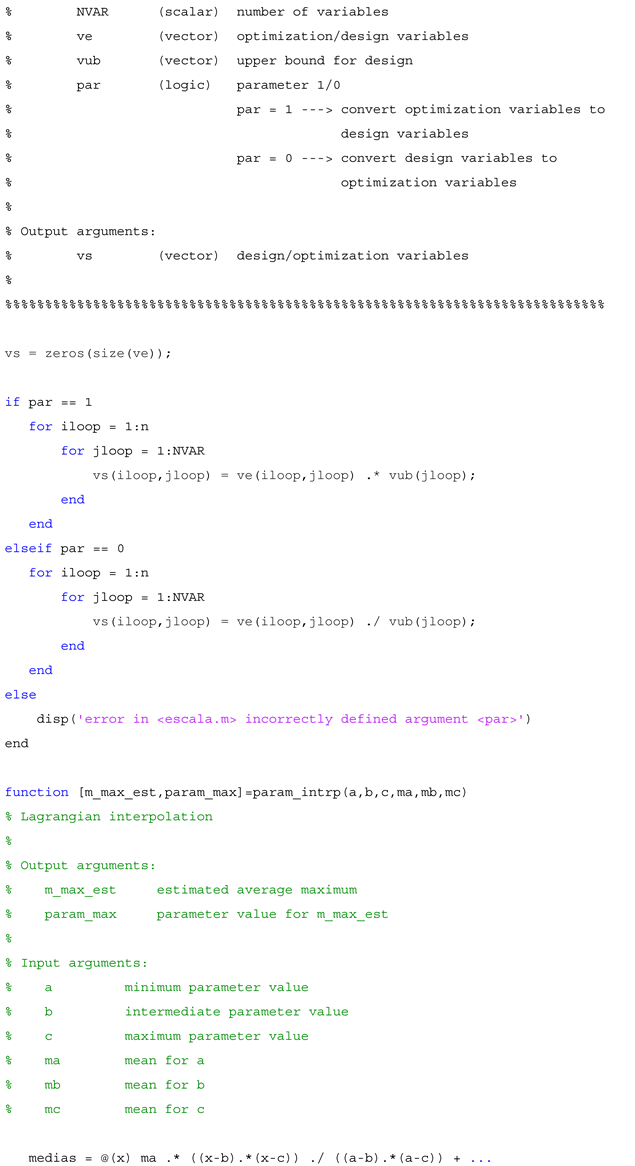

References
- Yang, X.-S. Nature-Inspired Optimization Algorithms, 2nd ed.; Elsevier: London, UK, 2021. [Google Scholar] [CrossRef]
- Wolpert, D.H.; Macready, W.G. No Free Lunch Theorems for Optimization. IEEE Trans. Evol. Comput. 1997, 1, 67–82. [Google Scholar] [CrossRef]
- Wolpert, D.H. Evolutionary computation and the processes of life: What the no free lunch theorems really mean: How to improve search algorithms. Ubiquity 2013, 2013, 1–15. [Google Scholar] [CrossRef]
- Joshi, S.K.; Bansal, J.C. Parameter tuning for meta-heuristics. Knowl.-Based Syst. 2020, 189, 105094. [Google Scholar] [CrossRef]
- Loubière, P.; Jourdan, A.; Siarry, P.; Chelouah, R. A sensitivity analysis method for driving the Artificial Bee Colony algorithm’s search process. Appl. Soft Comput. 2016, 41, 515–531. [Google Scholar] [CrossRef]
- Younis, M.T.; Yang, S. Hybrid meta-heuristic algorithms for independent job scheduling in grid computing. Appl. Soft Comput. 2018, 72, 498–517. [Google Scholar] [CrossRef]
- Yang, X.-S. Firefly Algorithms for Multimodal Optimization. In Stochastic Algorithms: Foundations and Applications, SAGA 2009; Watanabe, O., Zeugmann, T., Eds.; Lecture Notes in Computer, Sciences; Springer: Berlin/Heidelberg, Germany, 2009; Volume 5792, pp. 169–178. [Google Scholar] [CrossRef]
- Fister, I.; Fister, I., Jr.; Yang, X.S.; Brest, J. A comprehensive review of firefly algorithms. Swarm Evol. Comput. 2013, 13, 34–46. [Google Scholar] [CrossRef]
- Yang, X.-S. Cuckoo Search and Firefly Algorithm: Overview and Analysis. In Cuckoo Search and Firefly Algorithm. Theory and Applications, 1st ed.; Yang, X.-S., Ed.; Studies in Computational Intelligence; Springer: Cham, Swizerland, 2014; Volume 516, pp. 1–26. [Google Scholar] [CrossRef]
- Leite, J.P.B.; Topping, B.H.V. Parallel simulated annealing for structural optimization. Comput. Struct. 1999, 73, 545–564. [Google Scholar] [CrossRef]
- Thierauf, G.; Cai, J. Parallel evolution strategy for solving structural optimization. Eng. Struct. 1997, 19, 318–324. [Google Scholar] [CrossRef]
- Gomes, G.M.; Esposito, A. A Parallelised Firefly Algorithm for Structural Size and Shape Optimization with Multimodal Constraints. In Cuckoo Search and Firefly Algorithm. Theory and Applications, 1st ed.; Yang, X.-S., Ed.; Studies in Computational Intelligence; Springer: Cham, Swizerland, 2014; Volume 516, pp. 291–314. [Google Scholar] [CrossRef]
- Hasanҫebi, O.; Bahҫecioǧlu, T.; Kurҫ, Ö.; Saka, M.P. Optimum design of high-rise steel buildings using an evolution strategy integrated parallel algorithm. Comput. Struct. 2011, 89, 2037–2051. [Google Scholar] [CrossRef]
- Truong, V.H.; Nguyen, P.C.; Kim, S.E. An efficient method for optimizing space steel frames with semi-rigid joints using practical advanced analysis and the micro-genetic algorithm. J. Constr. Steel Res. 2017, 128, 416–427. [Google Scholar] [CrossRef]
- Huang, H.C. FPGA-Based Parallel Metaheuristic PSO Algorithm and Its Application to Global Path Planning for Autonomous Robot Navigation. J. Intell. Robot. Syst. 2014, 76, 475488. [Google Scholar] [CrossRef]
- Soria-Alcaraz, A.J.; Carpio, M.; Puga, H.; Swan, J.; Melin, P.; Terashima, H.; Sotelo-Figueroa, A.M. Parallel Meta-heuristic Approaches to the Course Timetabling Problem. In Design of Intelligent Systems Based on Fuzzy Logic, Neural Networks and Nature-Inspired Optimization; Melin, P., Castillo, O., Kacprzyk, J., Eds.; Studies in Computational Intelligence; Springer: Cham, Swizerland, 2015; Volume 601, pp. 391–417. [Google Scholar] [CrossRef]
- Wang, C.H.; Nguyen, T.T.; Pan, J.S.; Dao, T.K. An Optimization Approach for Potential Power Generator Outputs Based on Parallelized Firefly Algorithm. In Advances in Intelligent Information Hiding and Multimedia Signal Processing, Smart Innovation, Systems and Technologies; Pan, J.S., Tsai, P.W., Huang, H.C., Eds.; Springer: Cham, Swizerland, 2017; Volume 64, pp. 297–306. [Google Scholar] [CrossRef]
- Gandomi, A.H.; Yang, X.-S.; Alavi, A.H. Mixed variable structural optimization using Firefly Algorithm. Comput. Struct. 2011, 89, 2325–2336. [Google Scholar] [CrossRef]
- Talatahari, S.; Gandomi, A.H.; Yun, G.J. Optimum design of tower structures using Firefly Algorithm. Struct. Des. Tall Spec. Build. 2012, 23, 350–361. [Google Scholar] [CrossRef]
- Talbi, E. Metaheuristics: From Design to Implementation; John Wiley & Sons: Hoboken, NJ, USA, 2009. [Google Scholar]
- Sánchez-Olivares, G.; Tomás, A. Design of planar semi-rigid Steel frames using genetic algorithms and Component Method. J. Constr. Steel Res. 2013, 88, 267–278. [Google Scholar] [CrossRef]
- Eiben, A.E.; Smit, S.K. Parameter tuning for configuring and analyzing evolutionary algorithms. Swarm Evol. Comput. 2011, 1, 19–31. [Google Scholar] [CrossRef]
- Sánchez-Olivares, G.; Tomás, A. Optimization of Reinforced Concrete Sections under Compression and Biaxial Bending by Using a Parallel Firefly Algorithm. Appl. Sci. 2021, 11, 2076. [Google Scholar] [CrossRef]
- EN 1993-1-1:2005; Eurocode 3 Design of Steel Structures—Part 1—1: General Rules and Rules for Buildings. European Committee for Standardisation (CEN): Brussels, Belgium, 2005.
- Sánchez-Olivares, G.; Tomás, A. Improvements in meta-heuristic algorithms for minimum cost design of reinforced concrete rectangular sections under compression and biaxial bending. Eng. Struct. 2017, 130, 162–179. [Google Scholar] [CrossRef]
- Yang, X.-S.; Deb, S. Multiobjective cuckoo search for design optimization. Comput. Oper. Res. 2013, 40, 1616–1624. [Google Scholar] [CrossRef]
- Gandomi, A.H.; Yang, X.-S.; Talatahari, S.; Alavi, A.H. Firefly algorithm with chaos. Commun. Nonlinear Sci. Numer. Simul. 2013, 18, 89–98. [Google Scholar] [CrossRef]
- De Jong, K. Parameter Setting in EAs: A 30 Year Perspective. In Parameter Setting in Evolutionary Algorithms. Studies in Computational Intelligence; Lobo, F.G., Lima, C.F., Michalewicz, Z., Eds.; Springer: Berlin/Heidelberg, Germany, 2007; Volume 54, pp. 1–18. [Google Scholar] [CrossRef]
- Gandomi, A.H.; Kashani, A.R.; Roke, D.A.; Mousavi, M. Optimization of retaining wall design using recent swarm intelligence techniques. Eng. Struct. 2015, 103, 72–84. [Google Scholar] [CrossRef]
- Morris, M.D. Factorial sampling plans for preliminary computational experiments. Technometrics 1991, 33, 161–174. [Google Scholar] [CrossRef]
- Liang, J.; Qu, B.; Suganthan, P.; Chen, Q. Problem Definitions and Evaluation Criteria for the Cec 2015 Competition on Learning-Based Real-Parameter Single Objective Optimization; Technical Report201411A, Computational Intelligence Laboratory, Zhengzhou University, Zhengzhou China and Technical Report; Nanyang Technological University: Singapore, 2015. [Google Scholar]
- Cabrero, J.M.; Bayo, E. Development of practical design methods for steel structures with semi-rigid connections. Eng. Struct. 2005, 27, 1125–1137. [Google Scholar] [CrossRef]
- Ali, N.B.H.; Sellami, M.; Cutting-Decelle, A.F.; Mangin, J.C. Multi-stage production cost optimization of semi-rigid steel frames using genetic algorithms. Eng. Struct. 2009, 31, 2766–2778. [Google Scholar] [CrossRef]
- Xu, L.; Grierson, D.E. Computer-automated design of semirigid steel frameworks. J. Struct. Eng. 1993, 119, 1740–1760. [Google Scholar] [CrossRef]
- Foley, C.M.; Schinler, D. Automated design of steel frames using advanced analysis and object-oriented evolutionary computation. J. Struct. Eng. 2003, 129, 648–660. [Google Scholar] [CrossRef]
- Kameshki, E.S.; Saka, M.P. Genetic algorithm based optimum design of nonlinear planar steel frames with various semi-rigid connections. J. Constr. Steel Res. 2003, 59, 109–134. [Google Scholar] [CrossRef]
- Benavides, E.M. Information, entropy and its relationship to design. In Advanced Engineering Design. An Integrated Approach; Benavides, E.M., Ed.; Woodhead Publishing: Cambridge, UK, 2012; pp. 41–258. [Google Scholar] [CrossRef]
- Harte, J.; Newman, E.A. Maximum information entropy: A foundation for ecological theory. Trends Ecol. Evol. 2014, 29, 384–389. [Google Scholar] [CrossRef]
- Souza de Cursi, E.; Sampaio, R. Maximum Entropy and Information. In Uncertainty Quantification and Stochastic Modeling with Matlab; Souza de Cursi, E., Sampaio, R., Eds.; Elsevier: London, UK, 2015; pp. 133–175. [Google Scholar] [CrossRef]
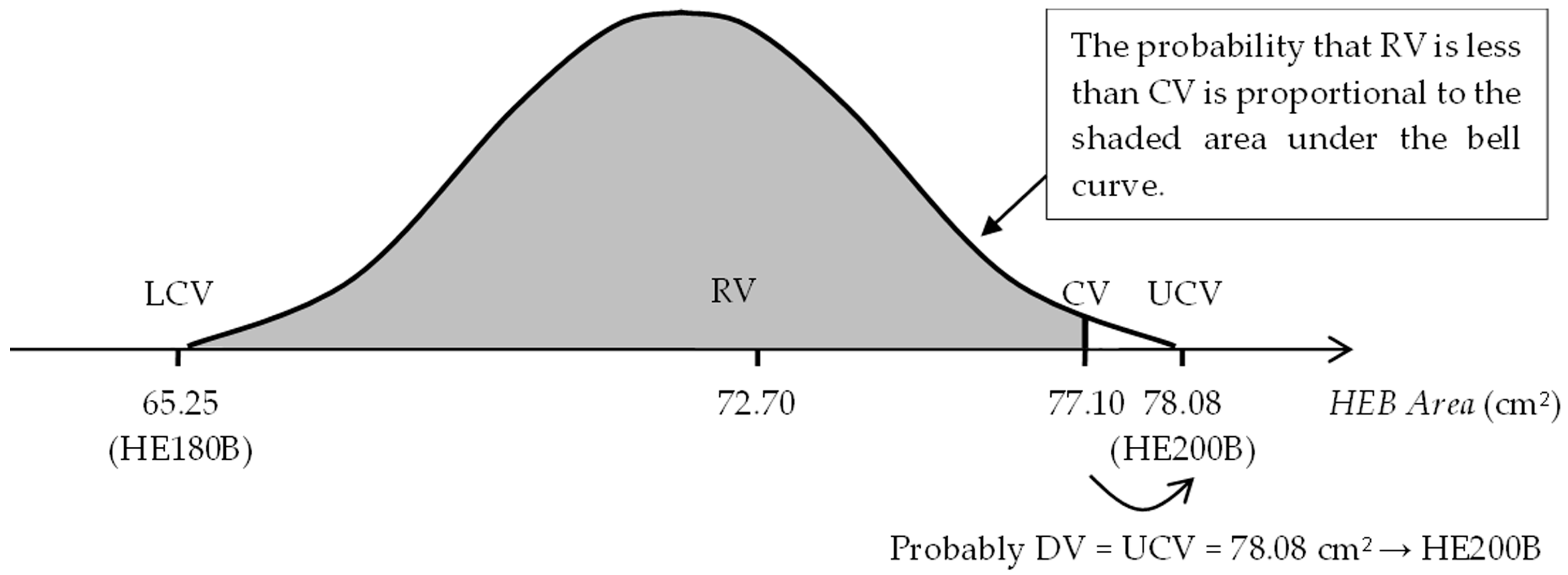
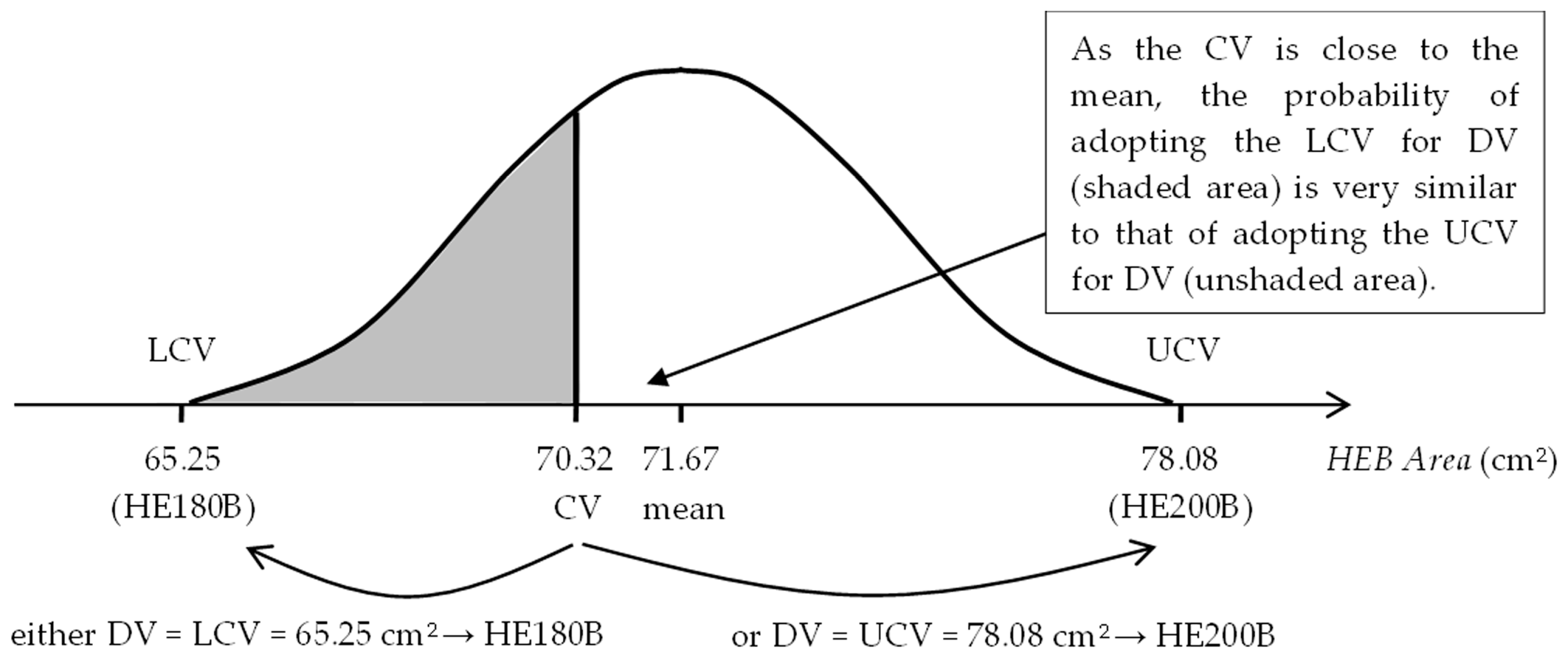
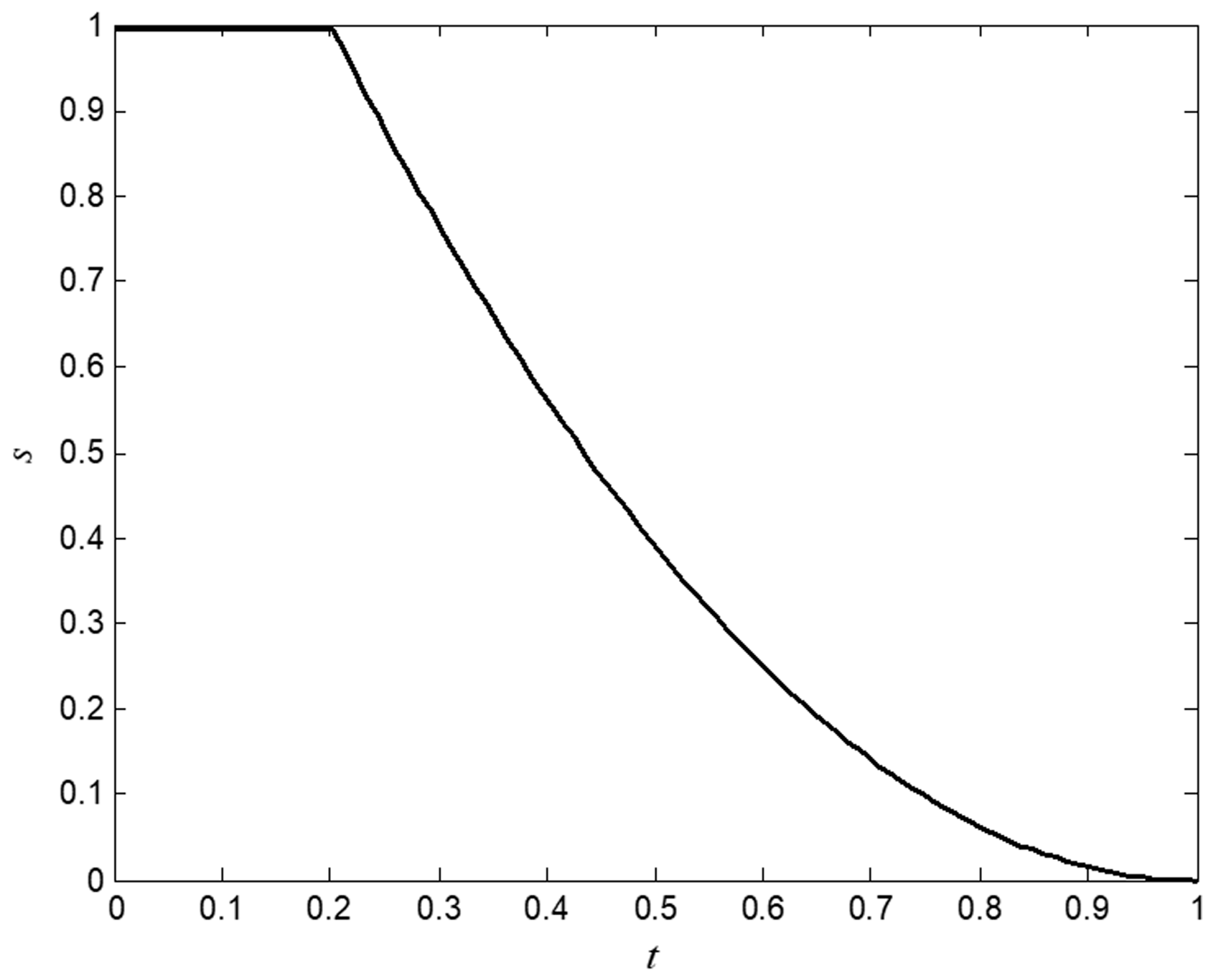
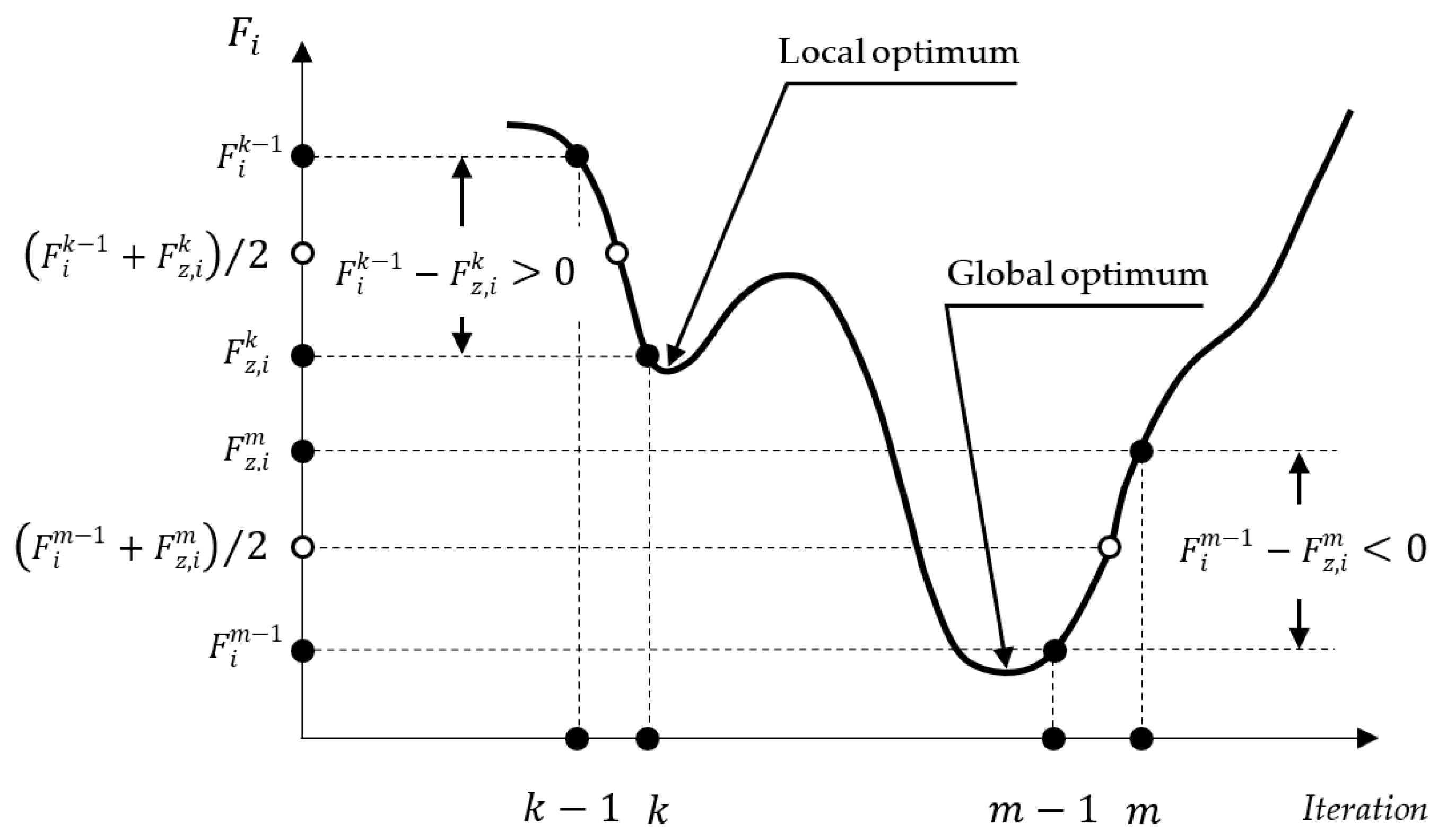
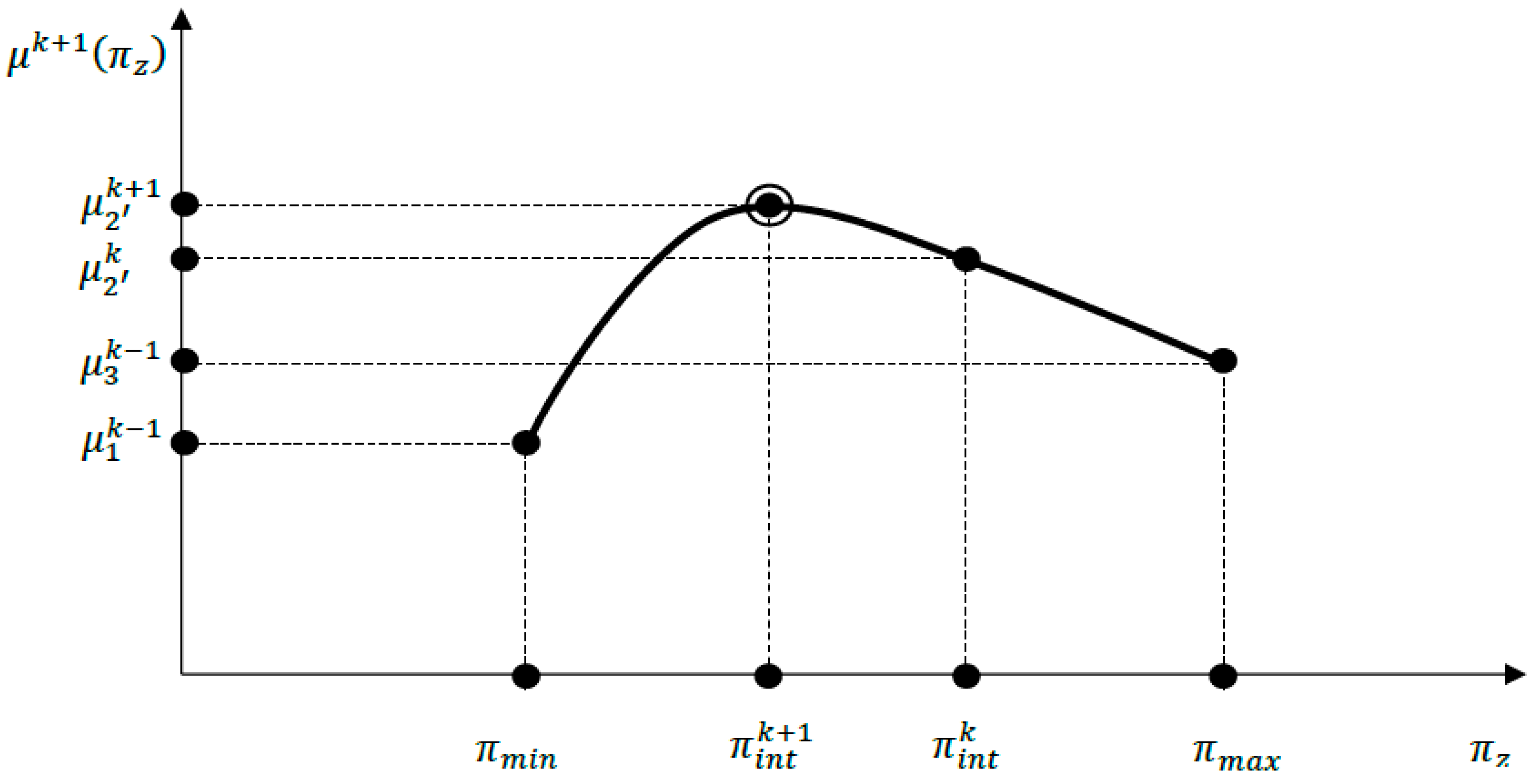
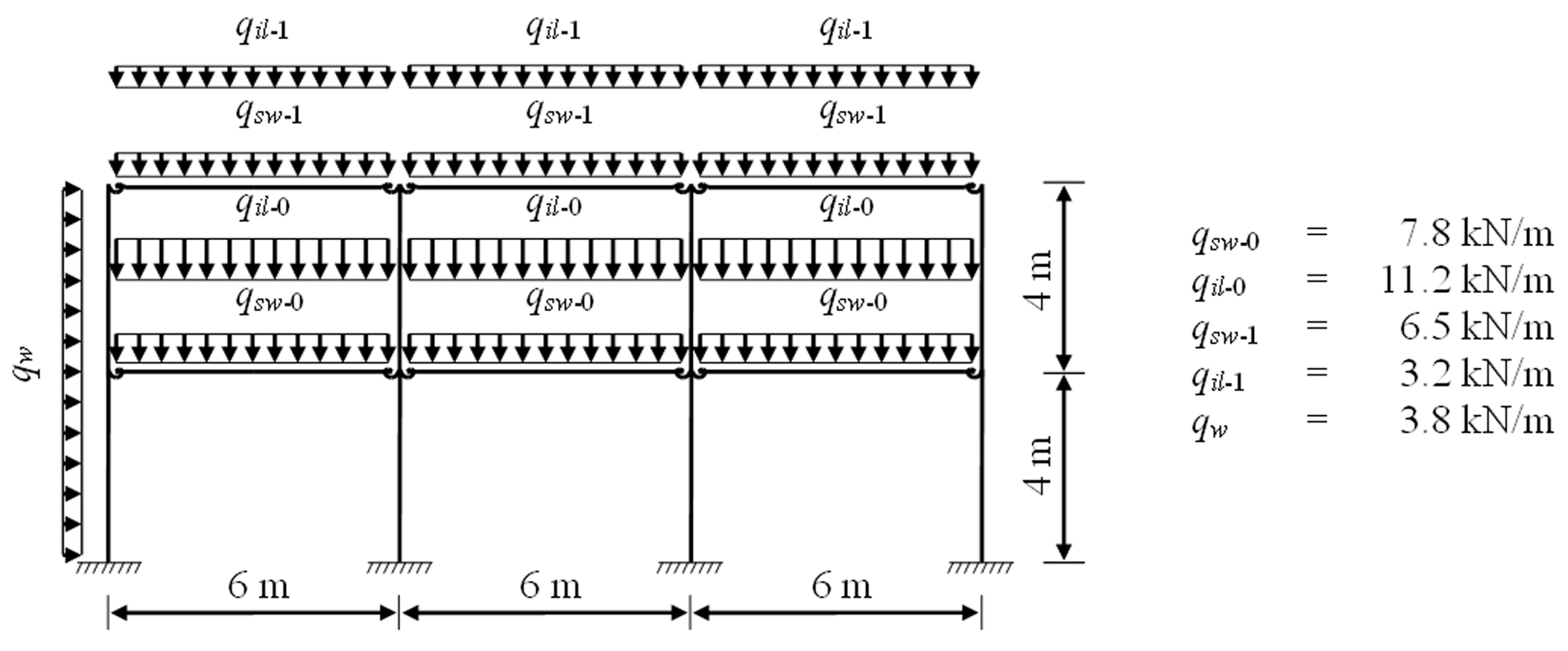
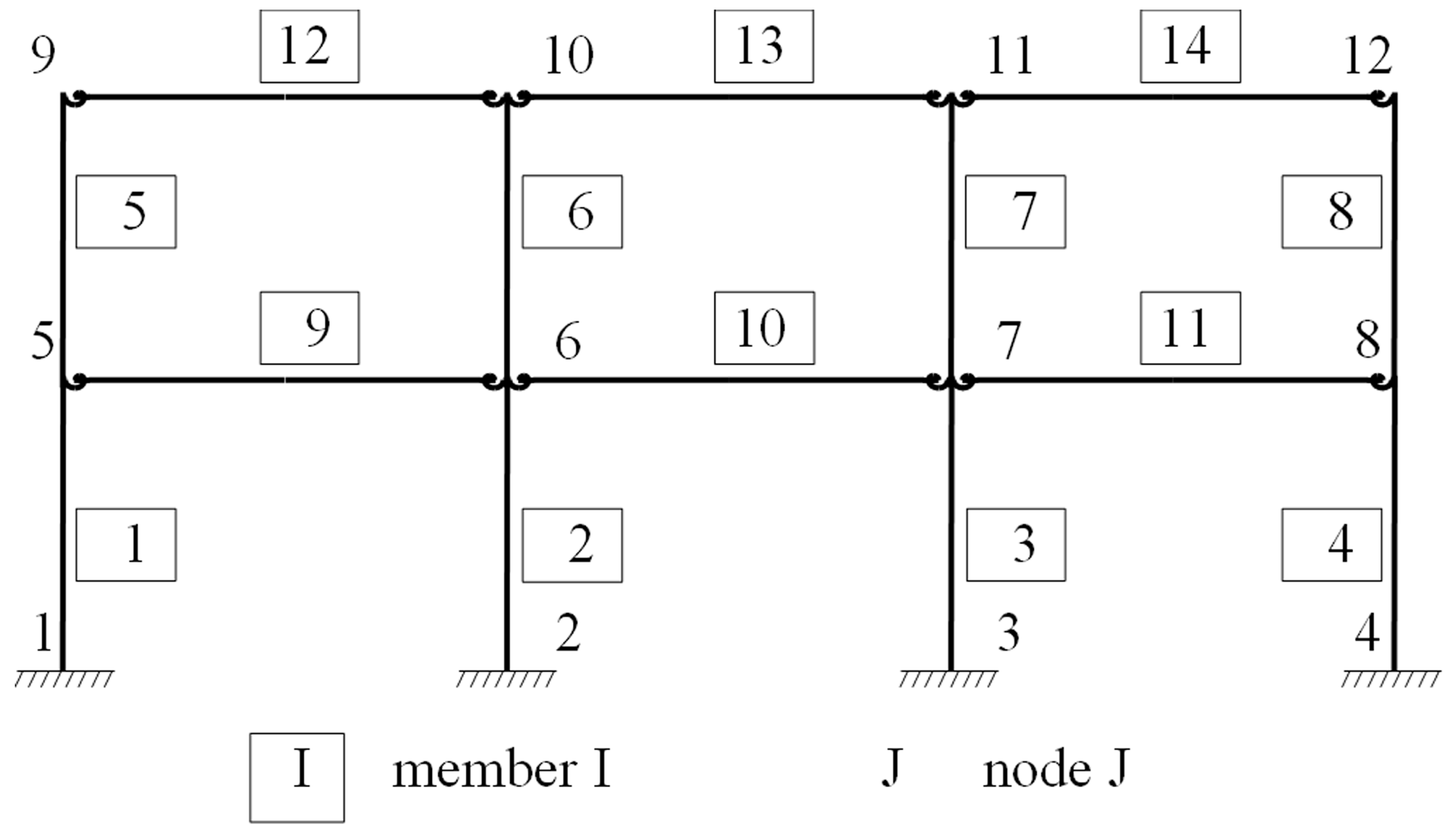
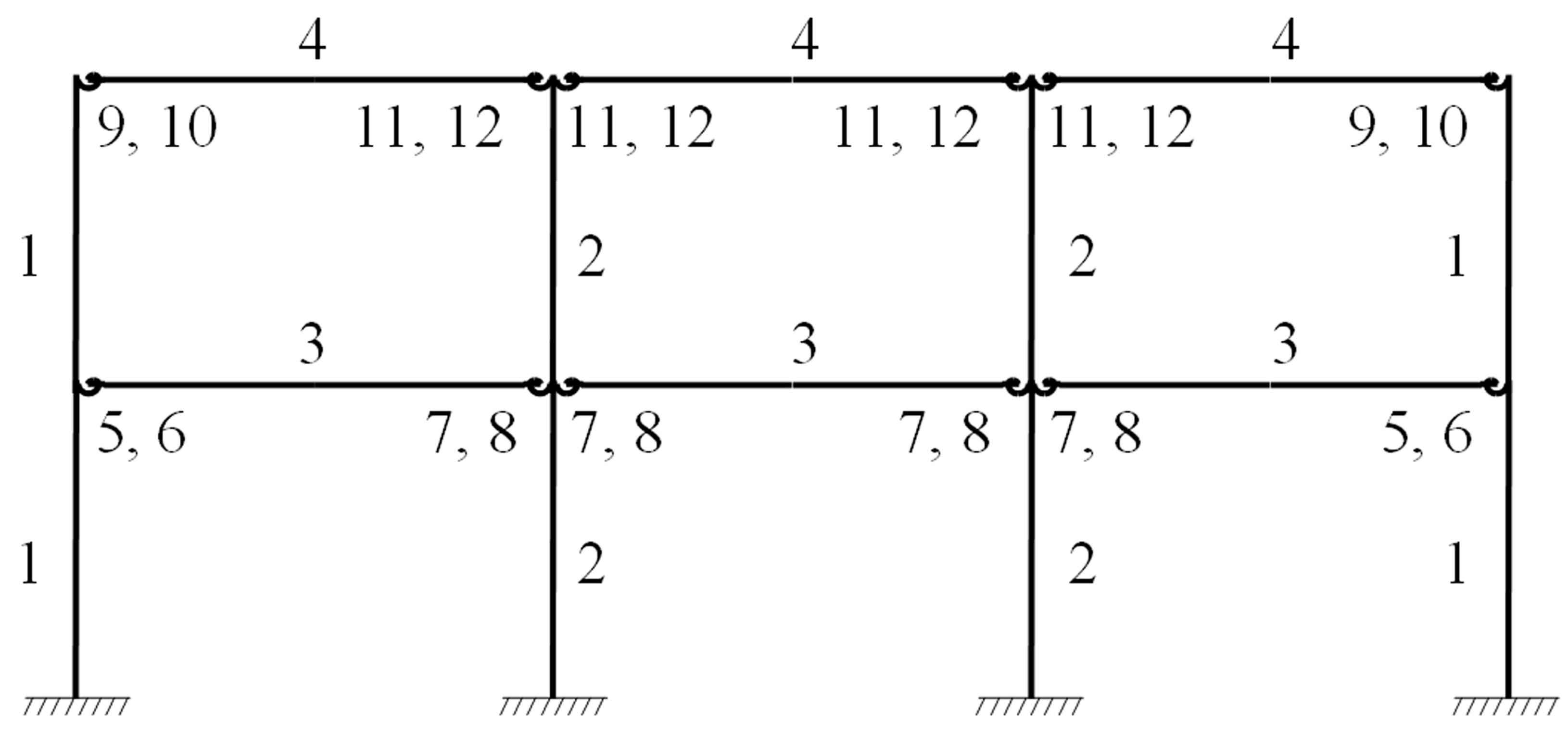
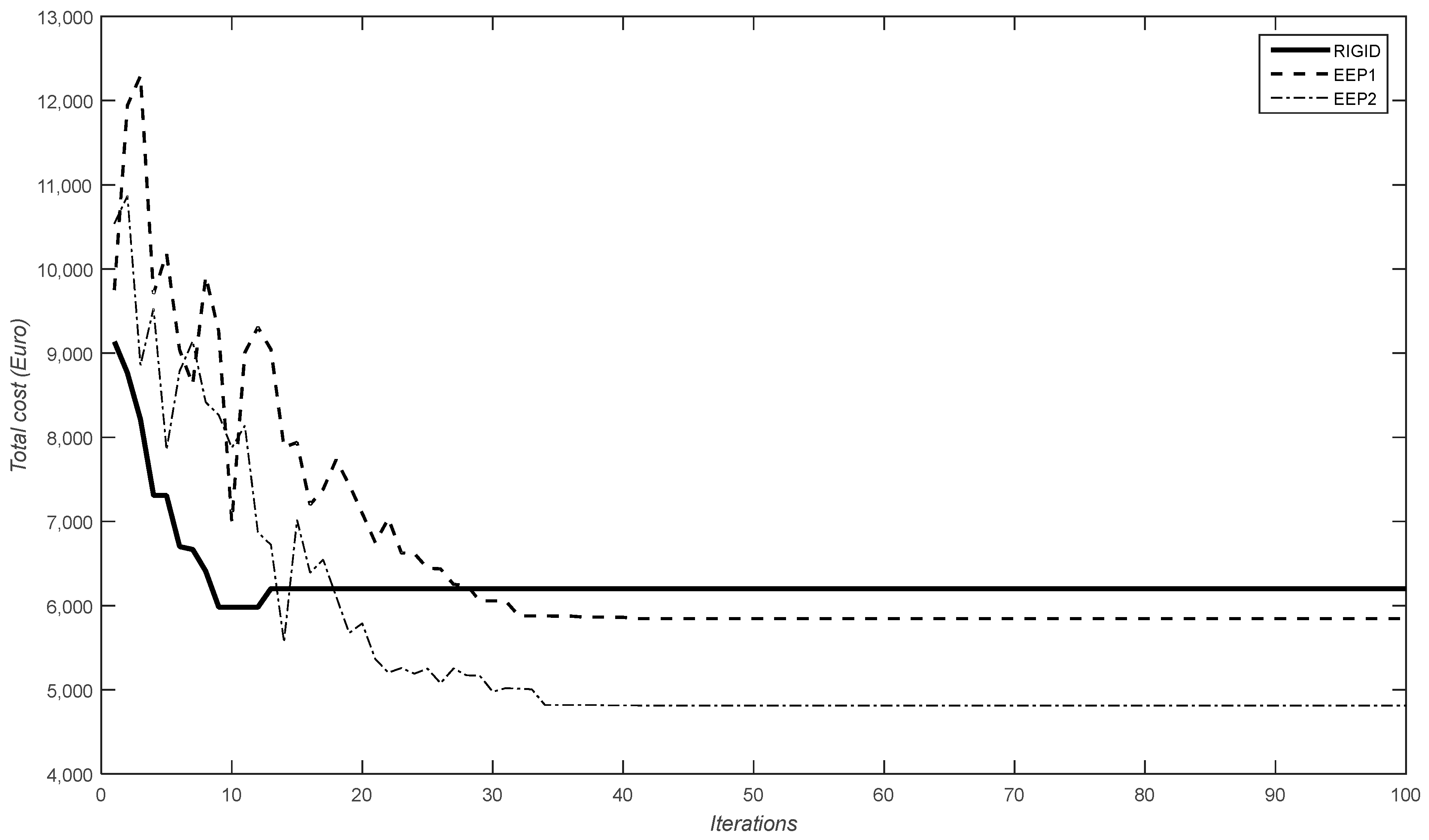
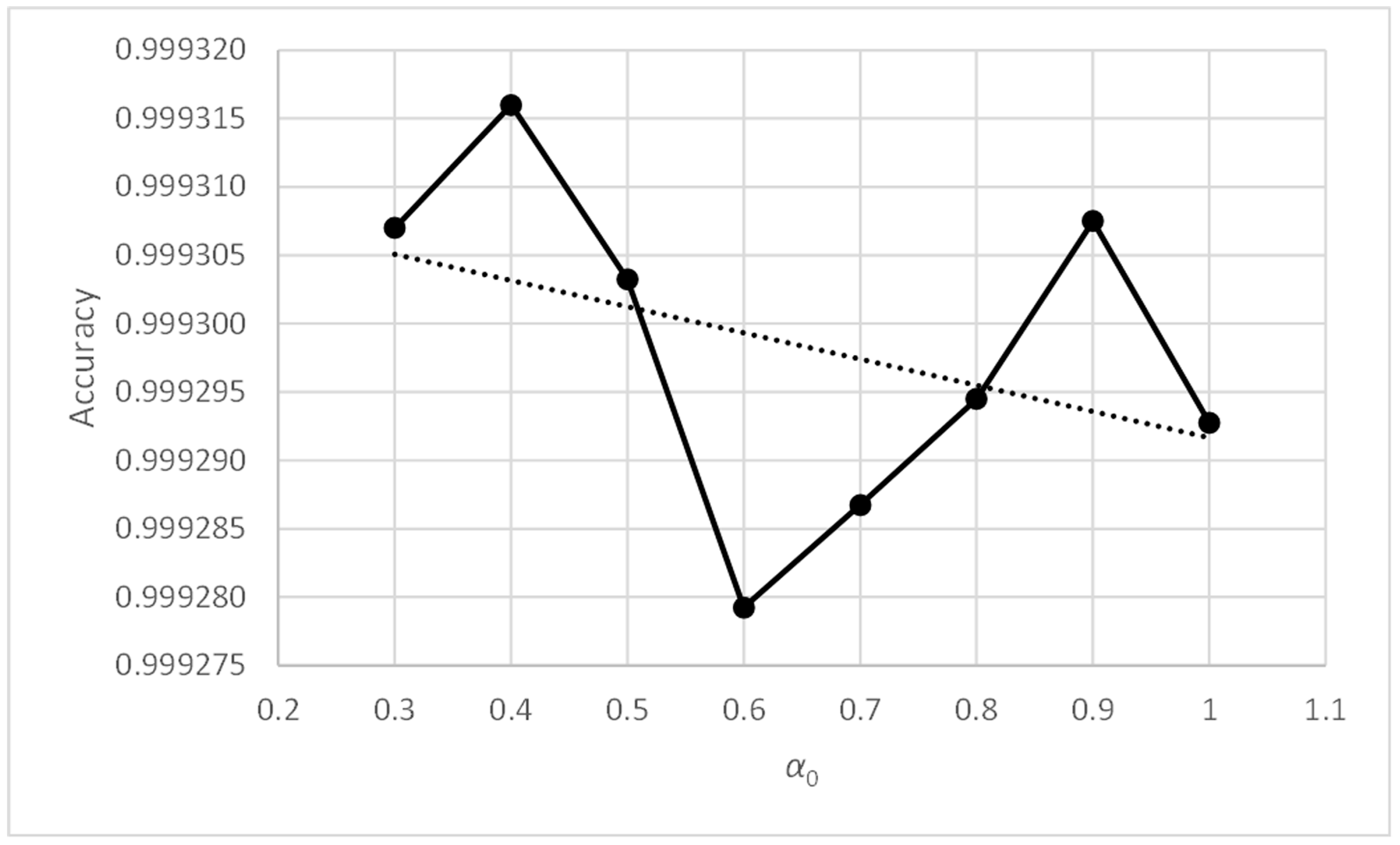
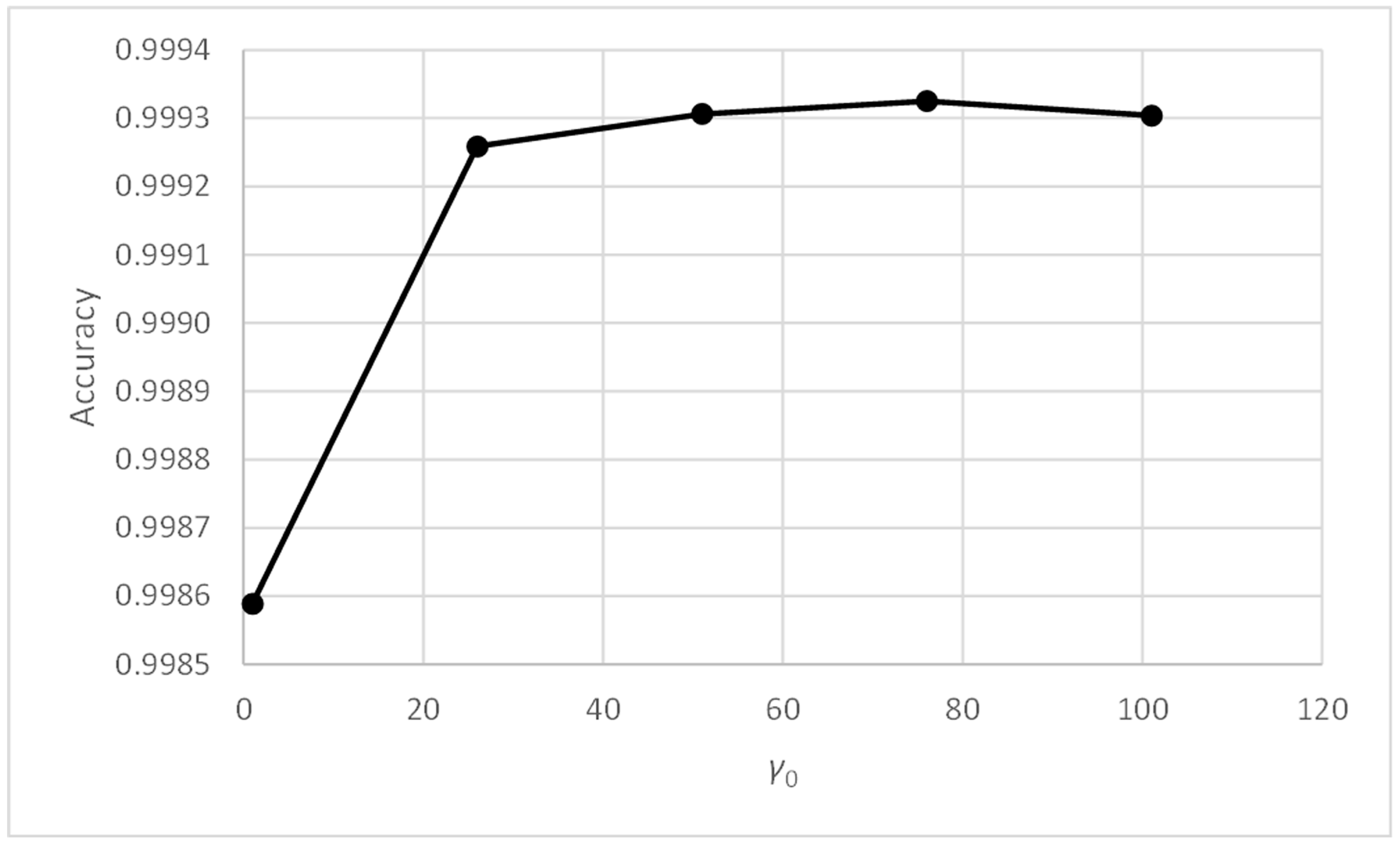
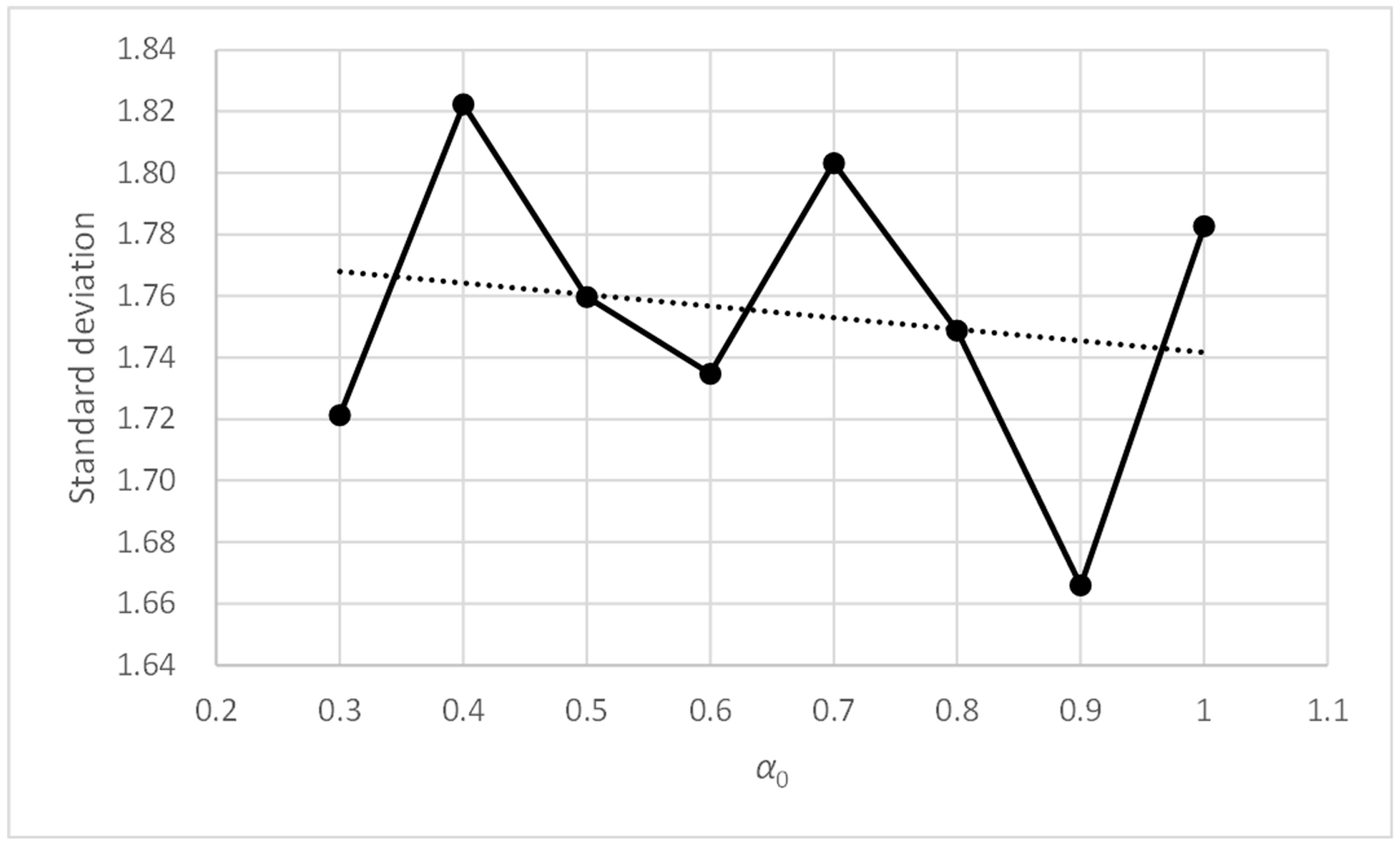
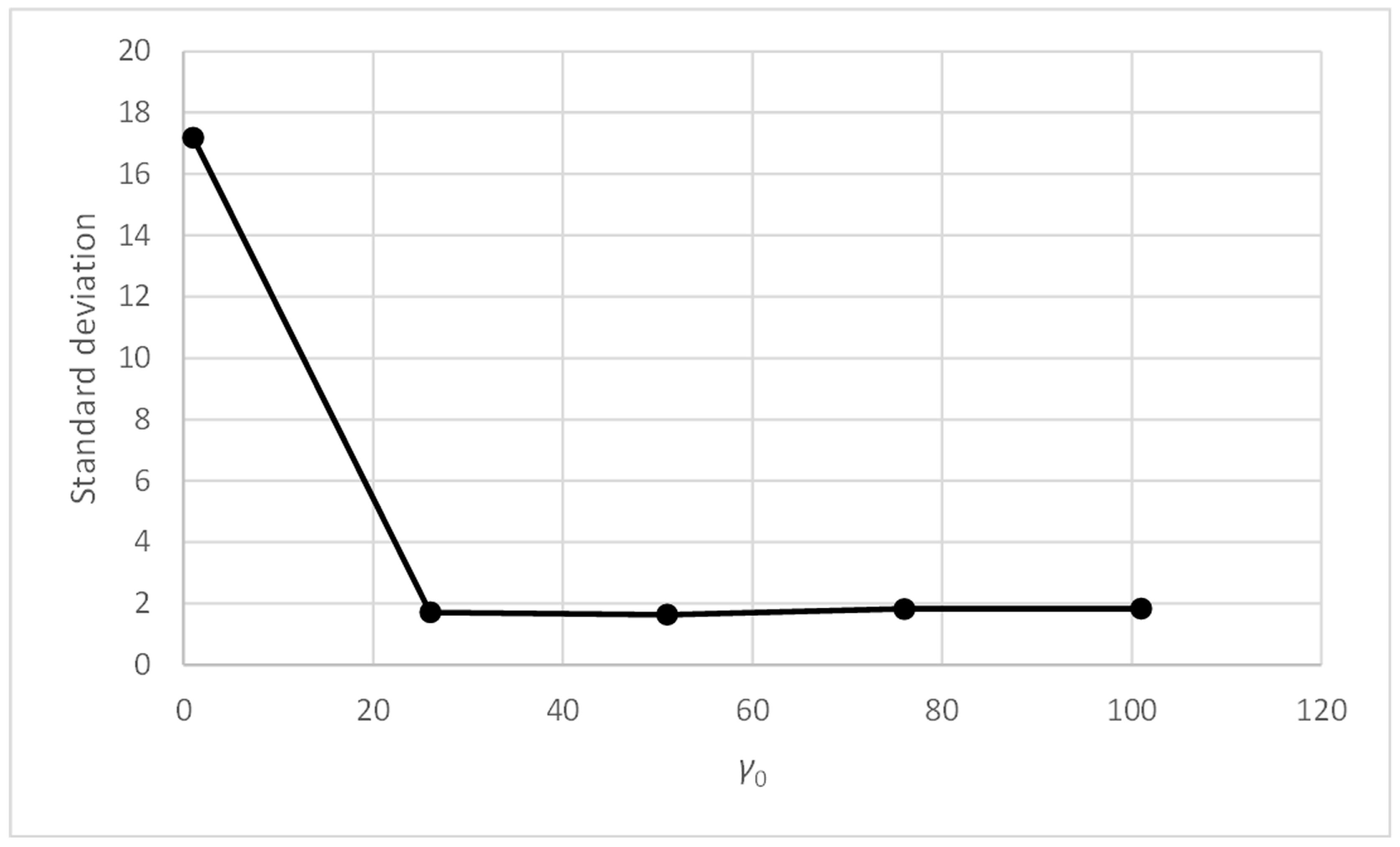
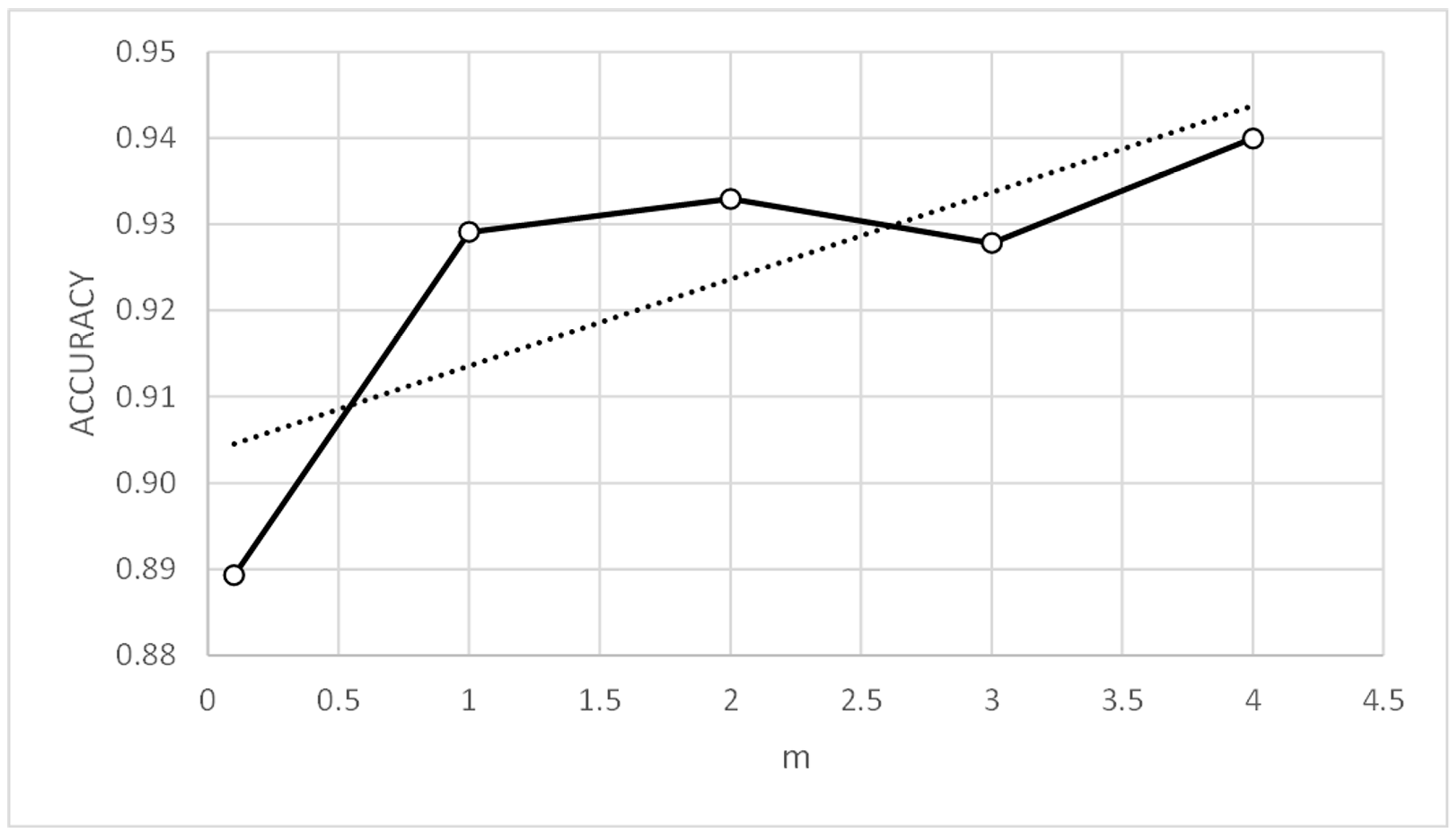
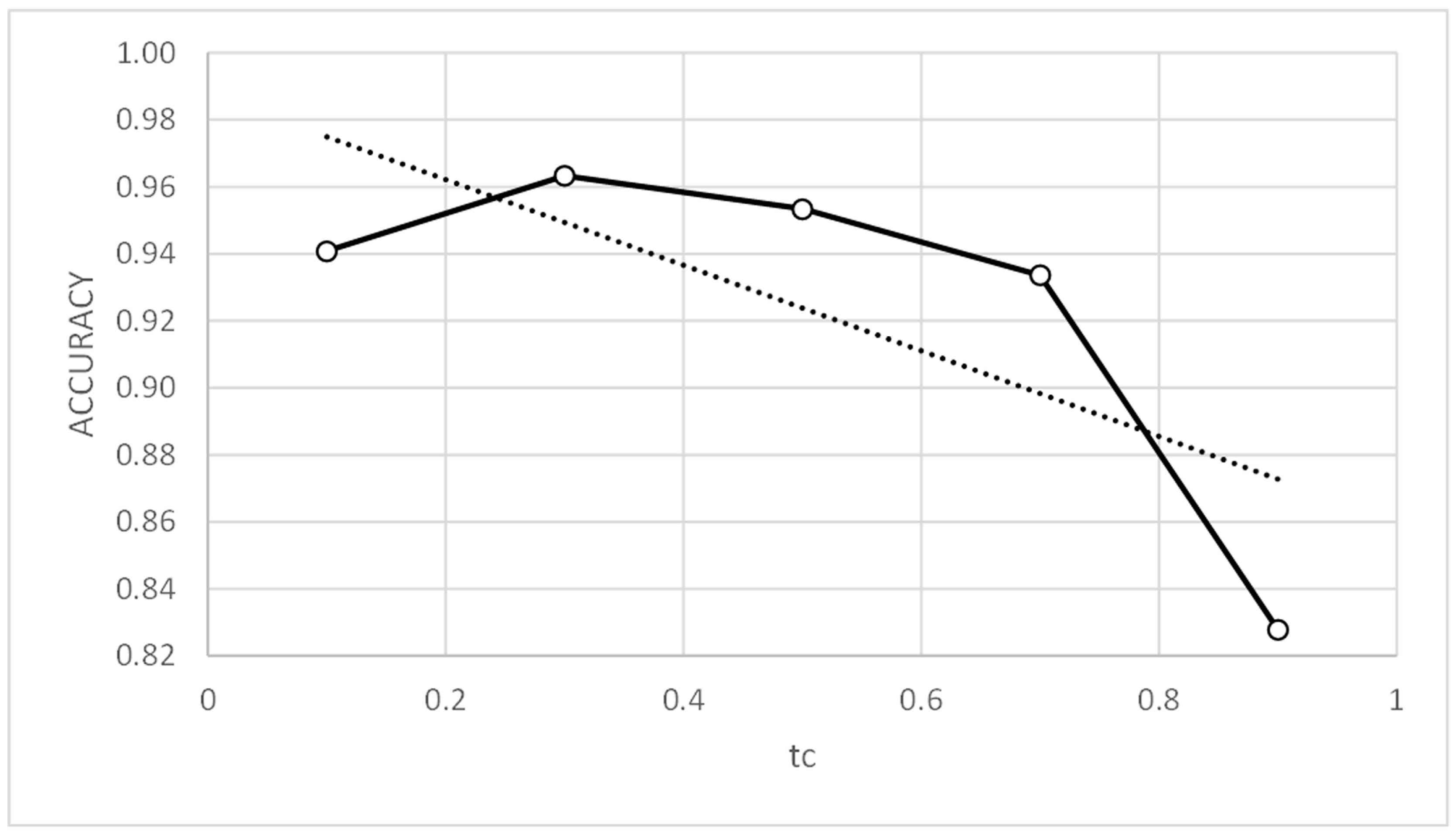
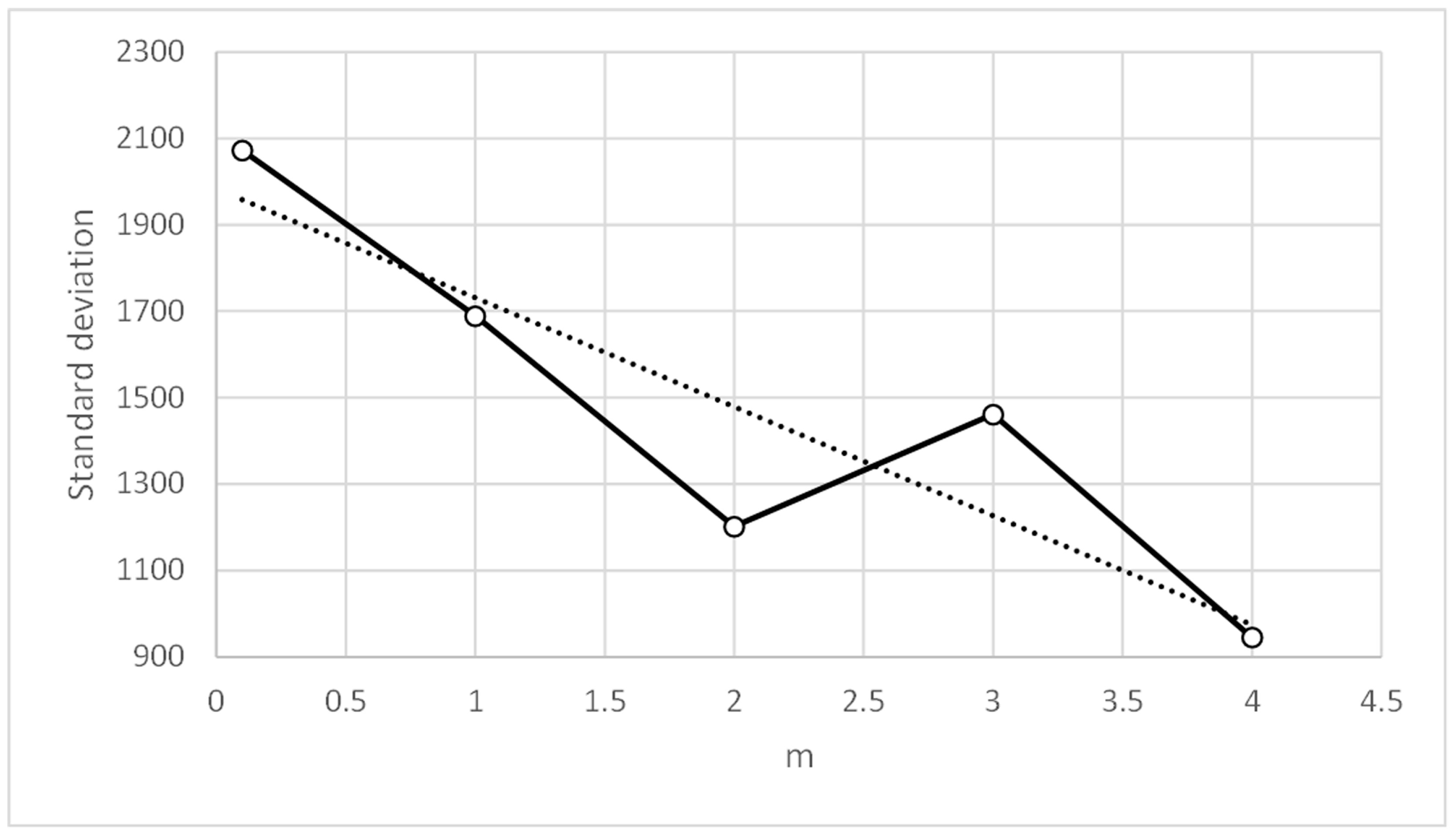
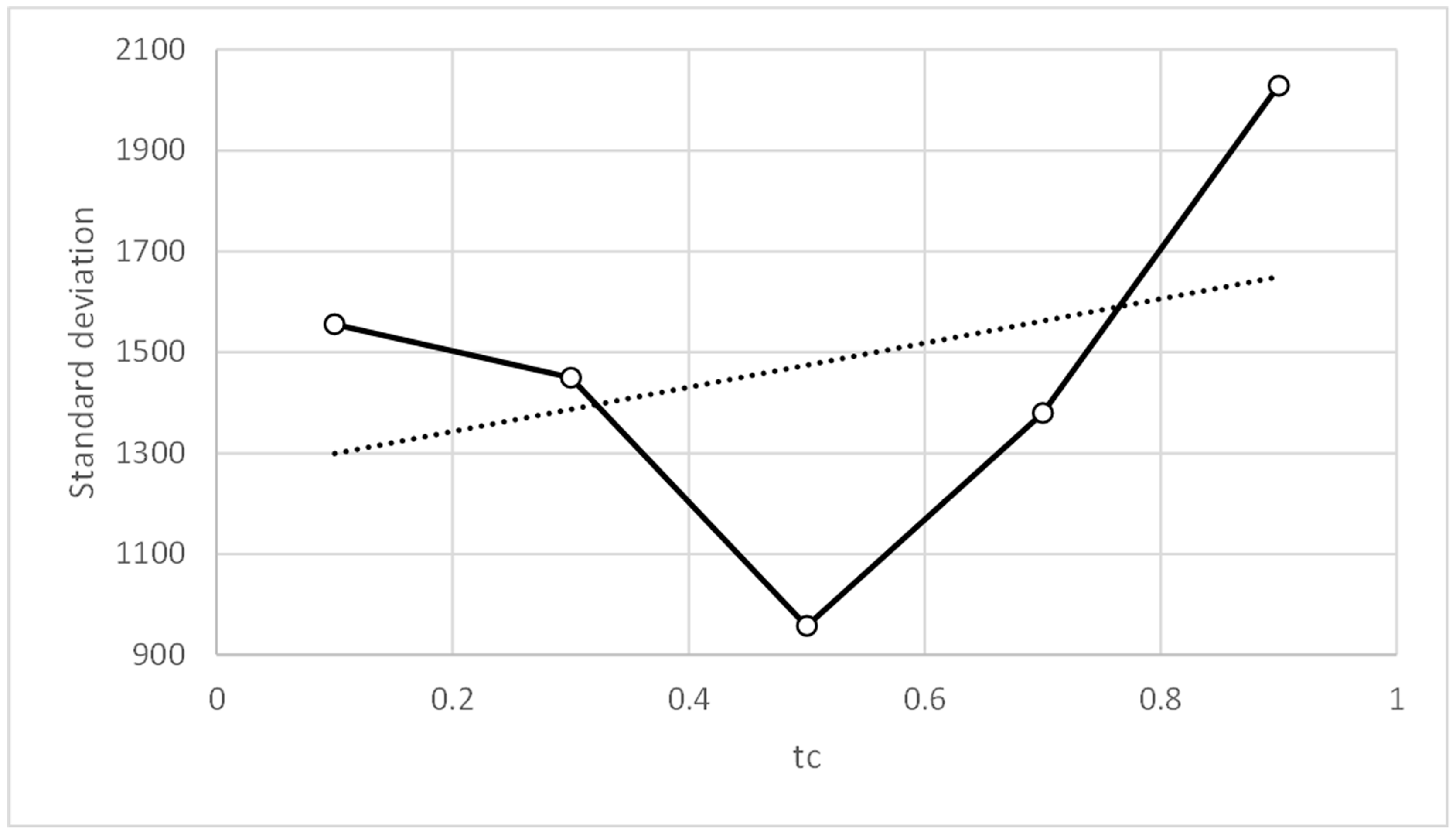
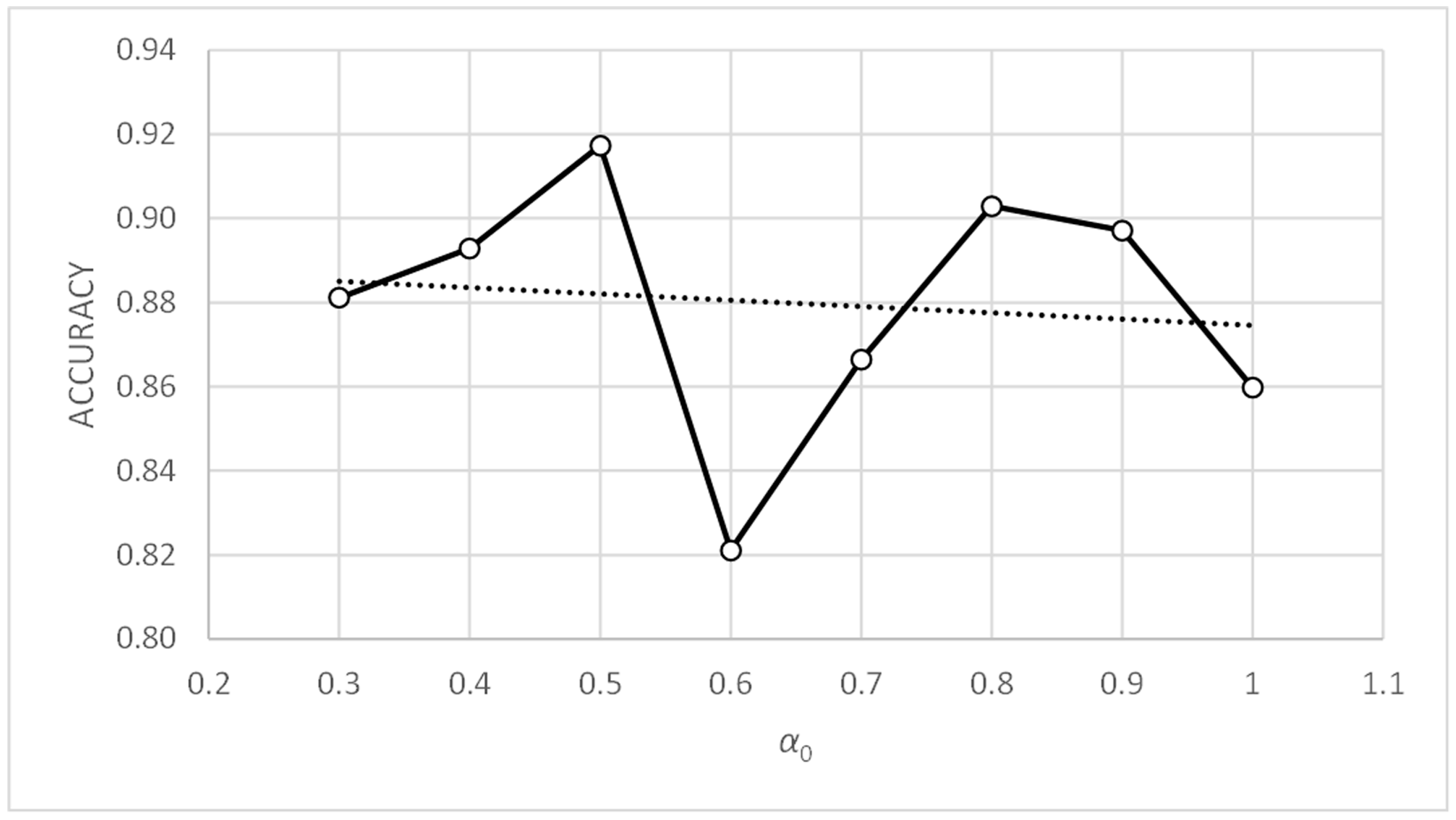
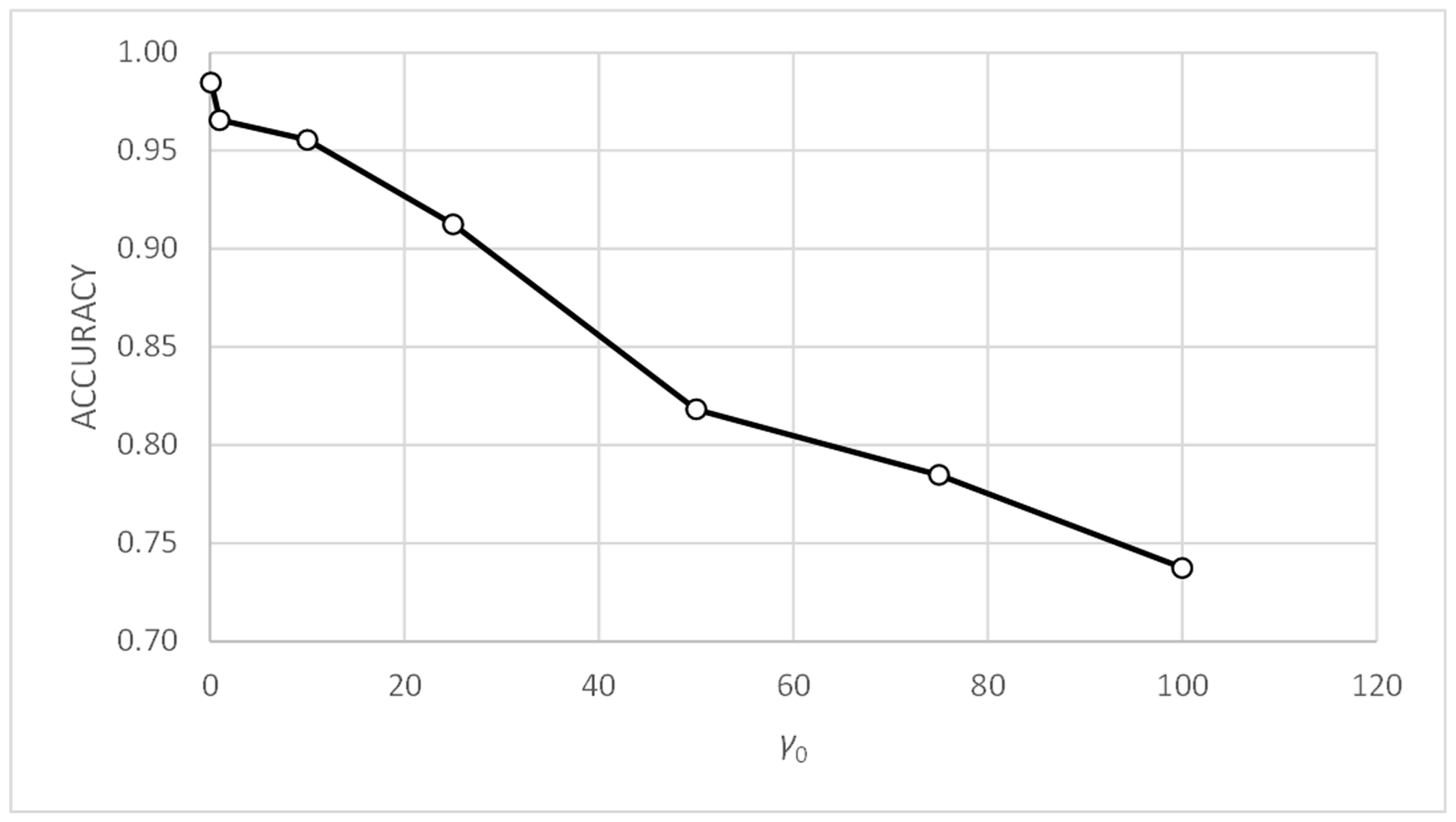
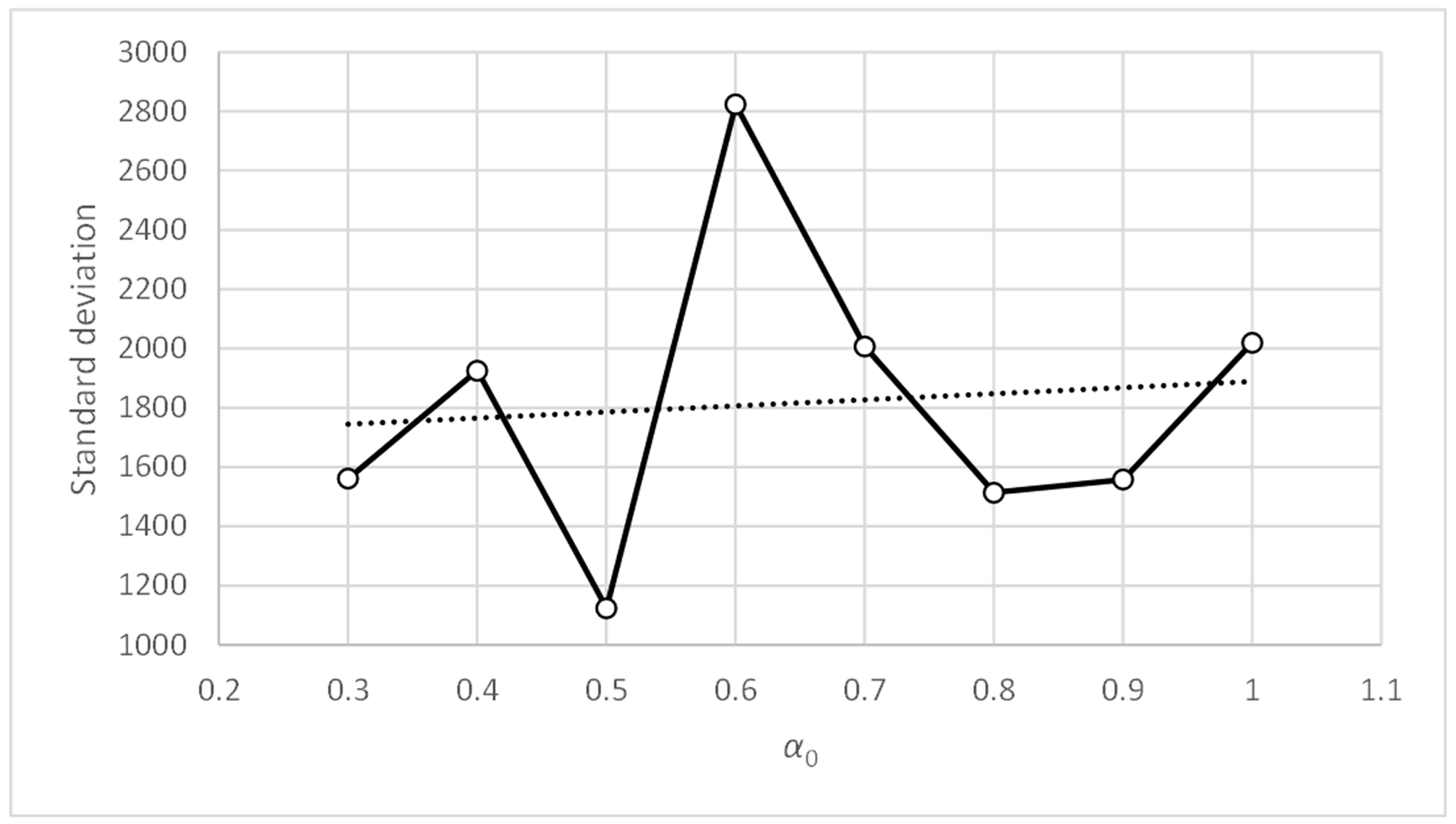
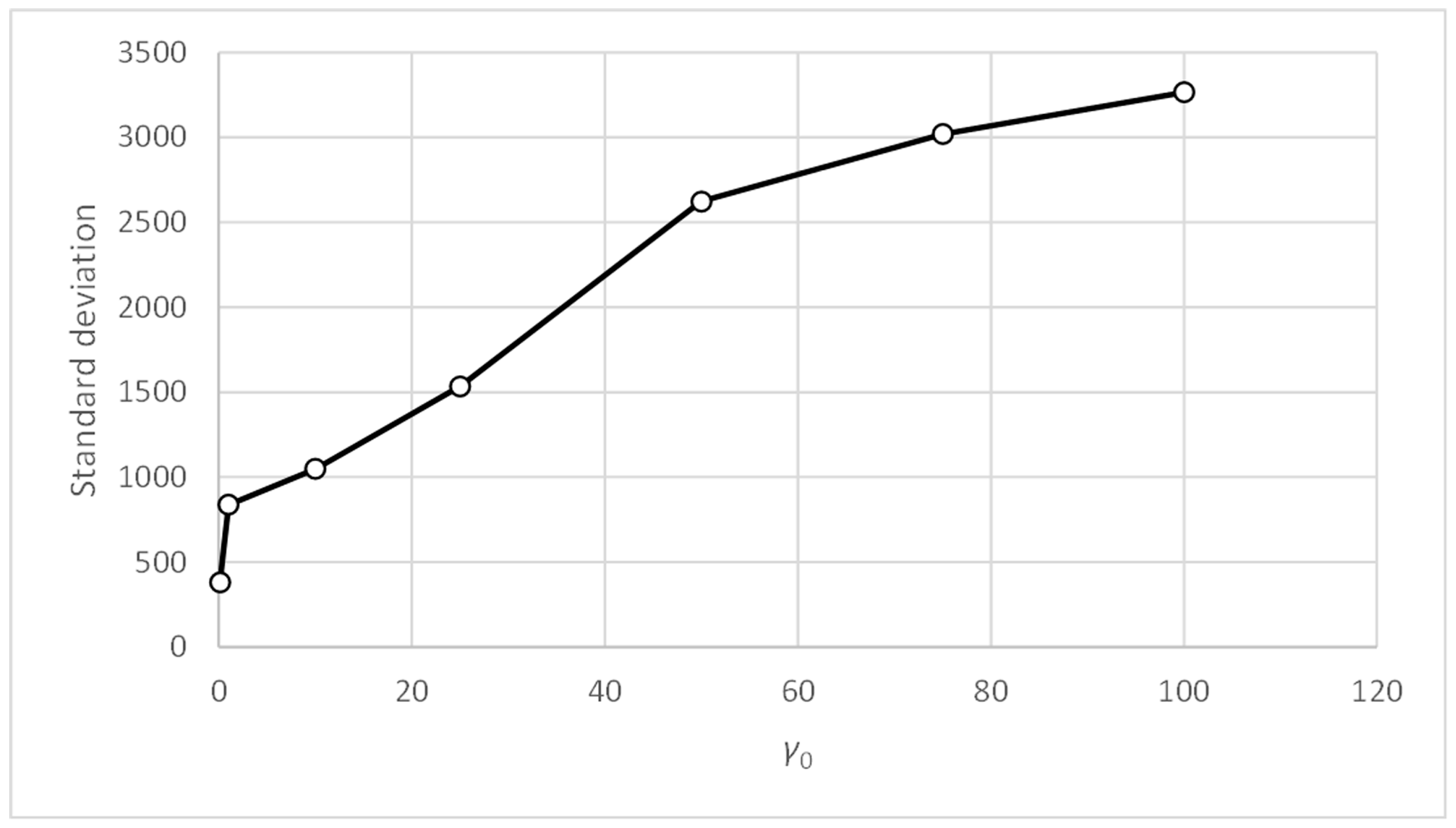
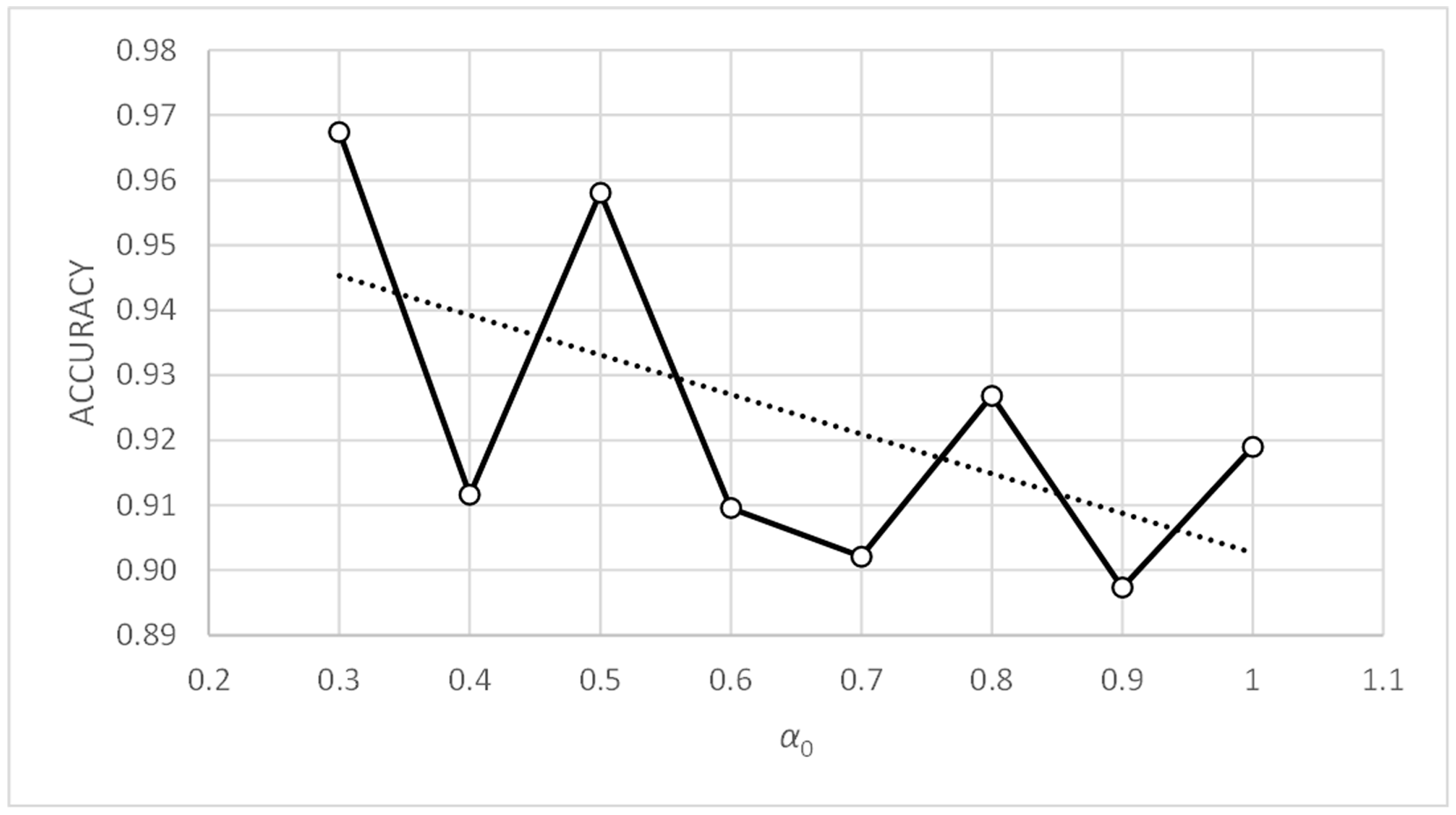
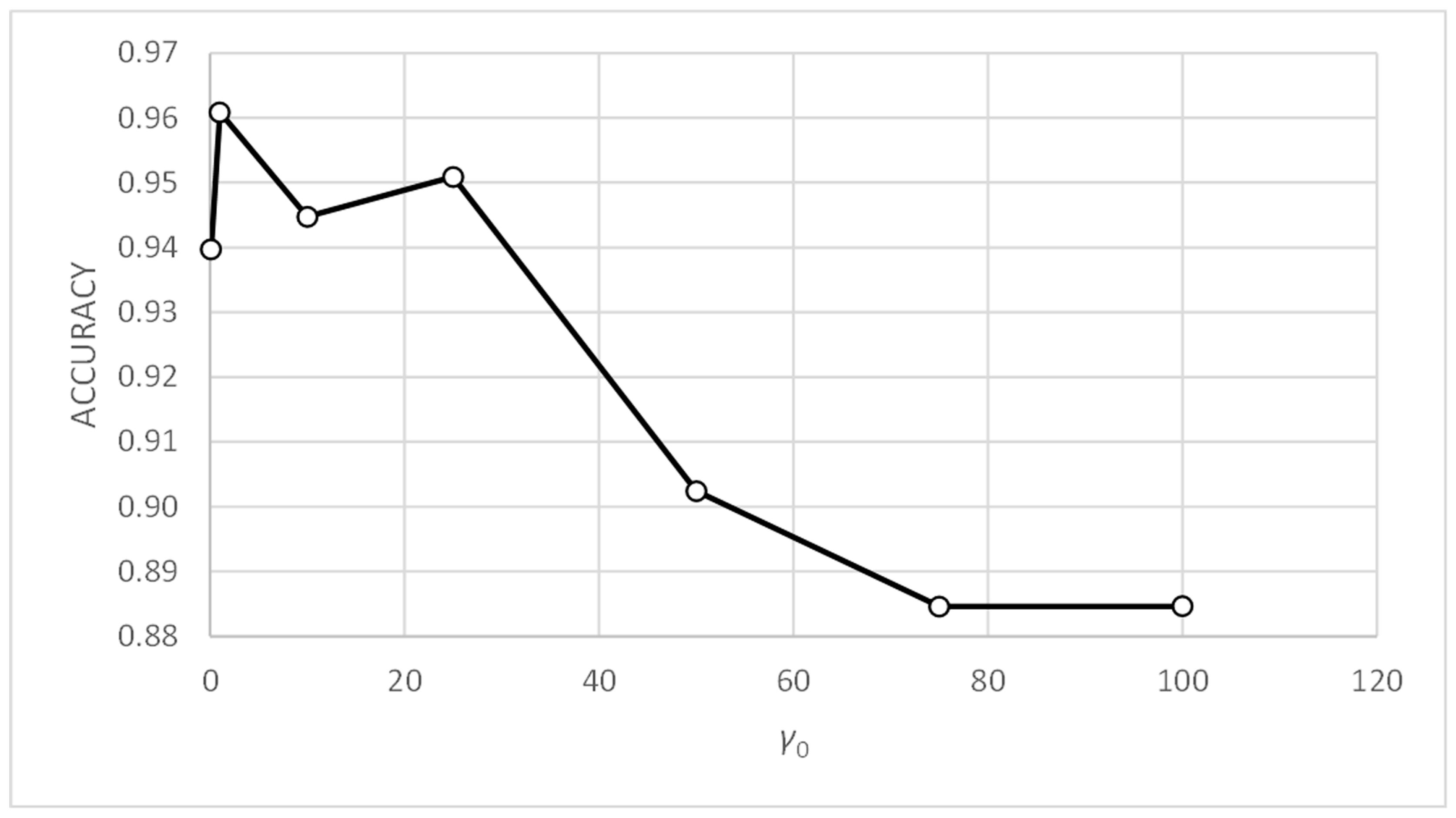
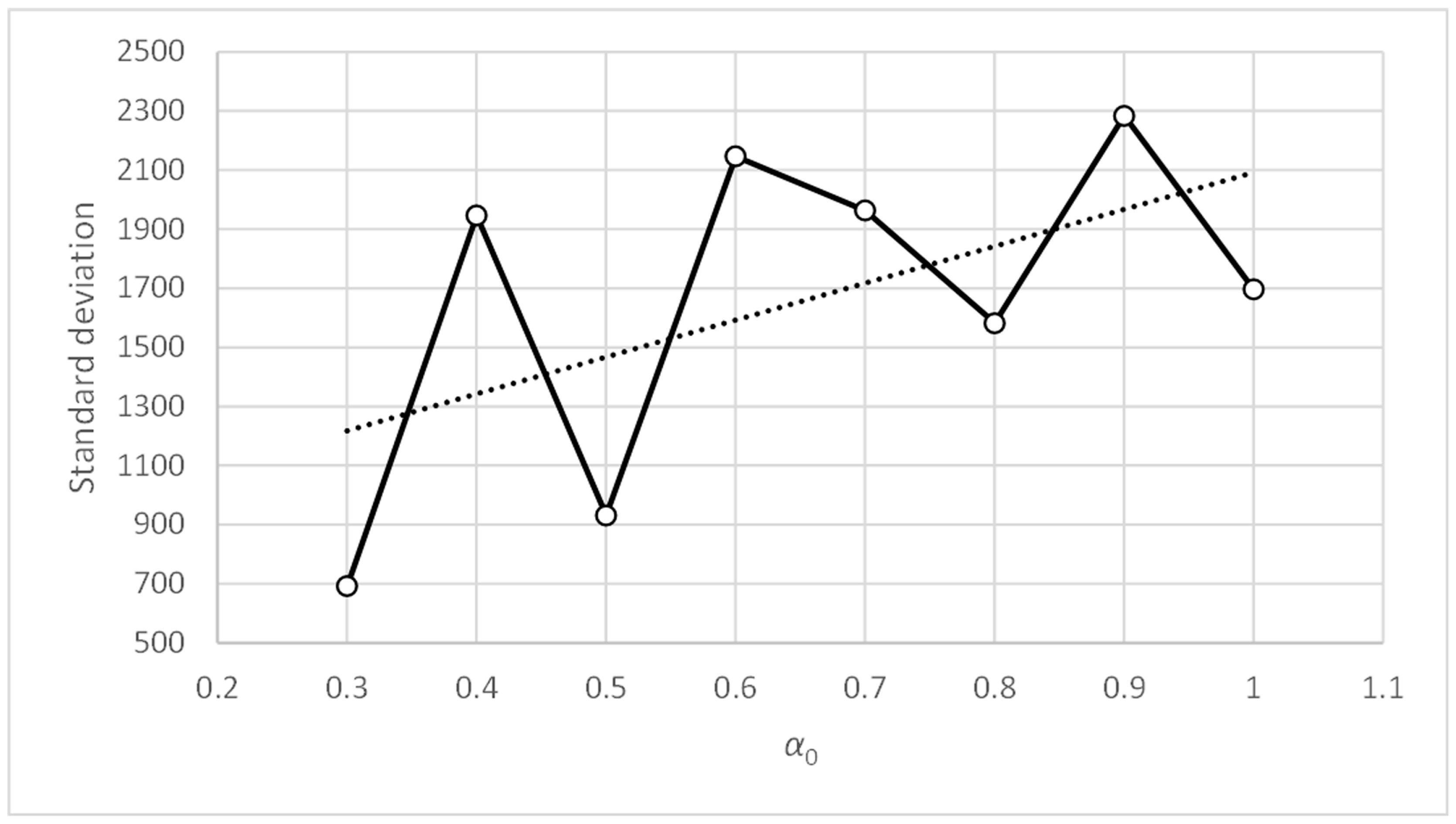
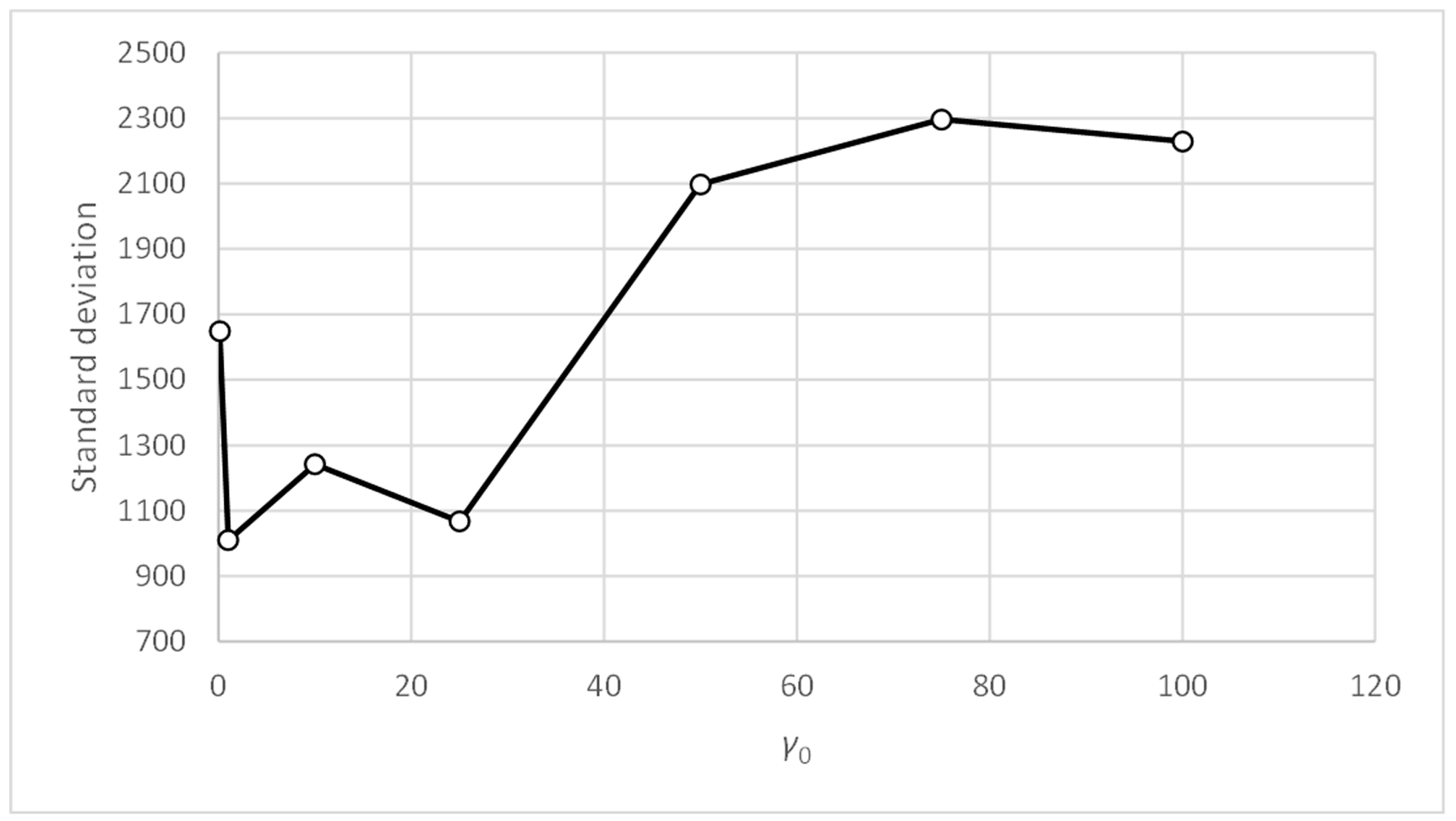
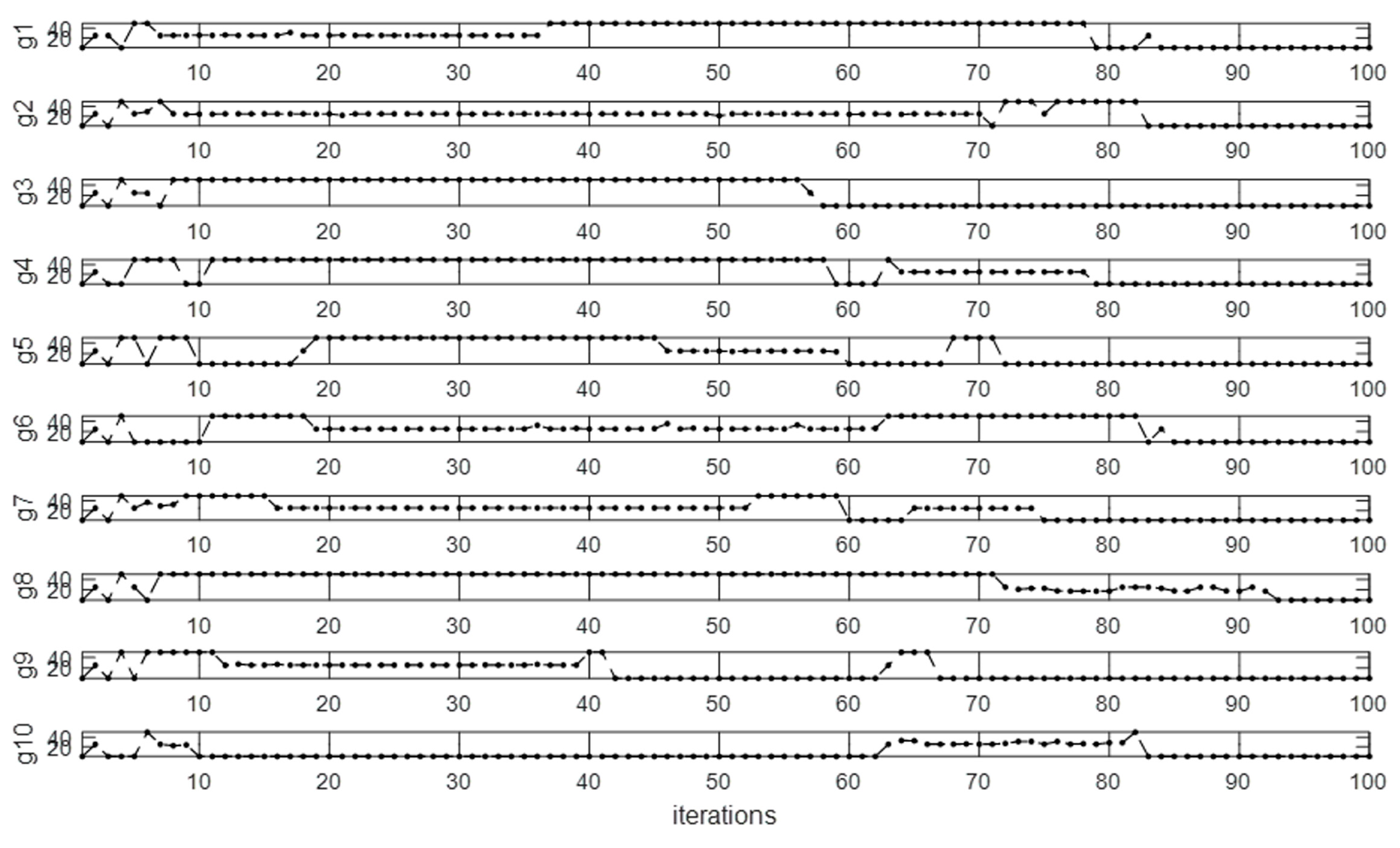
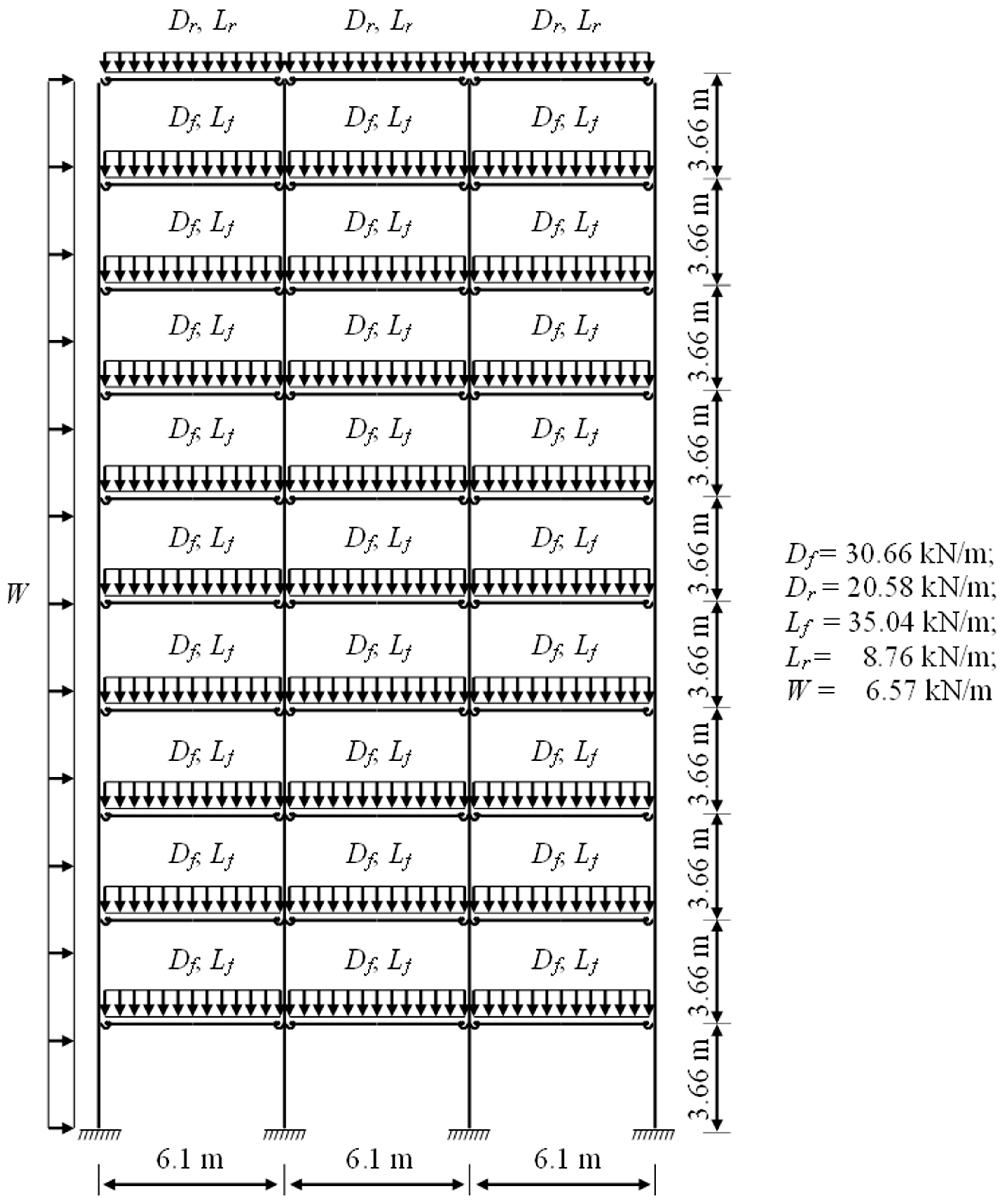
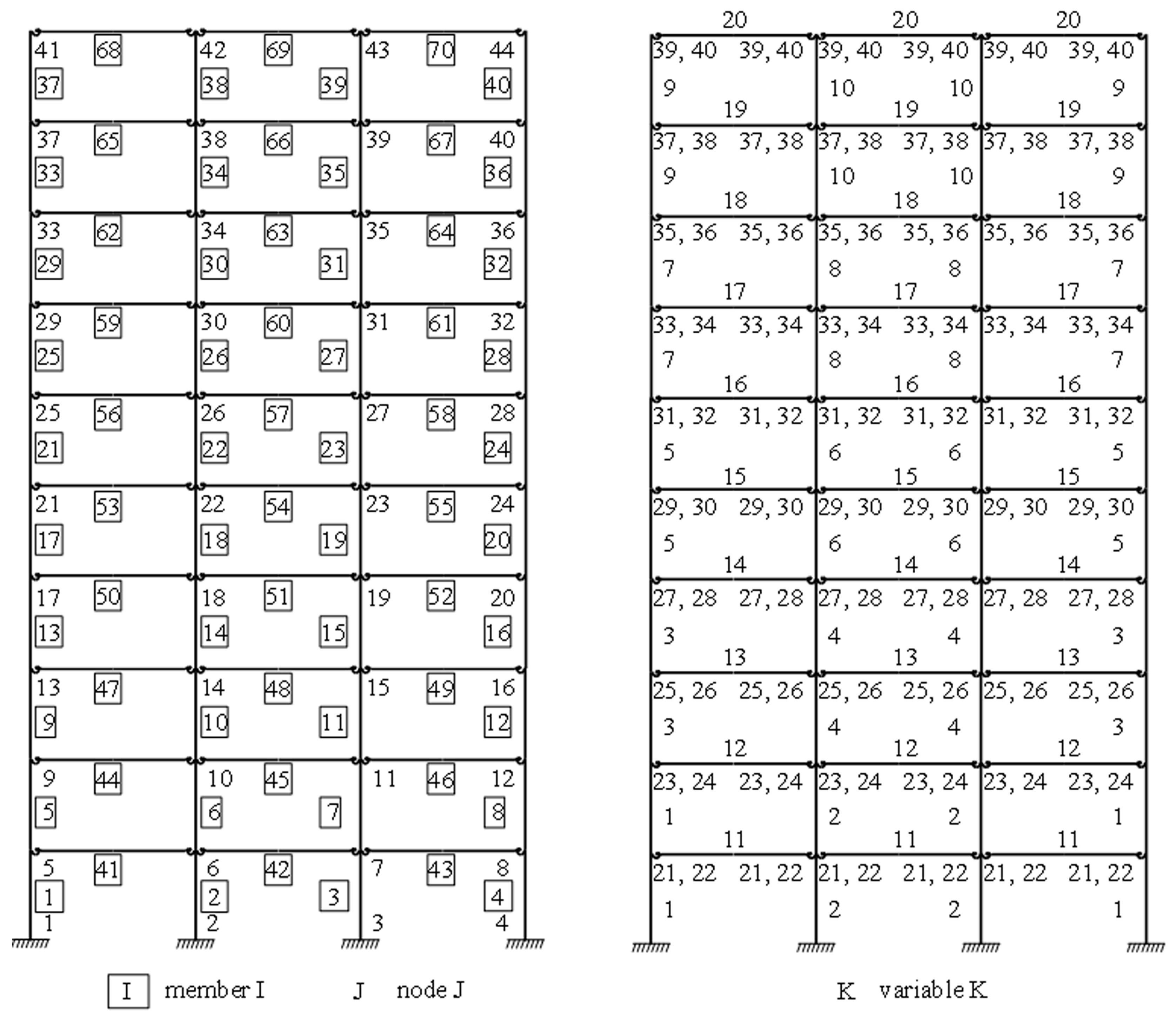
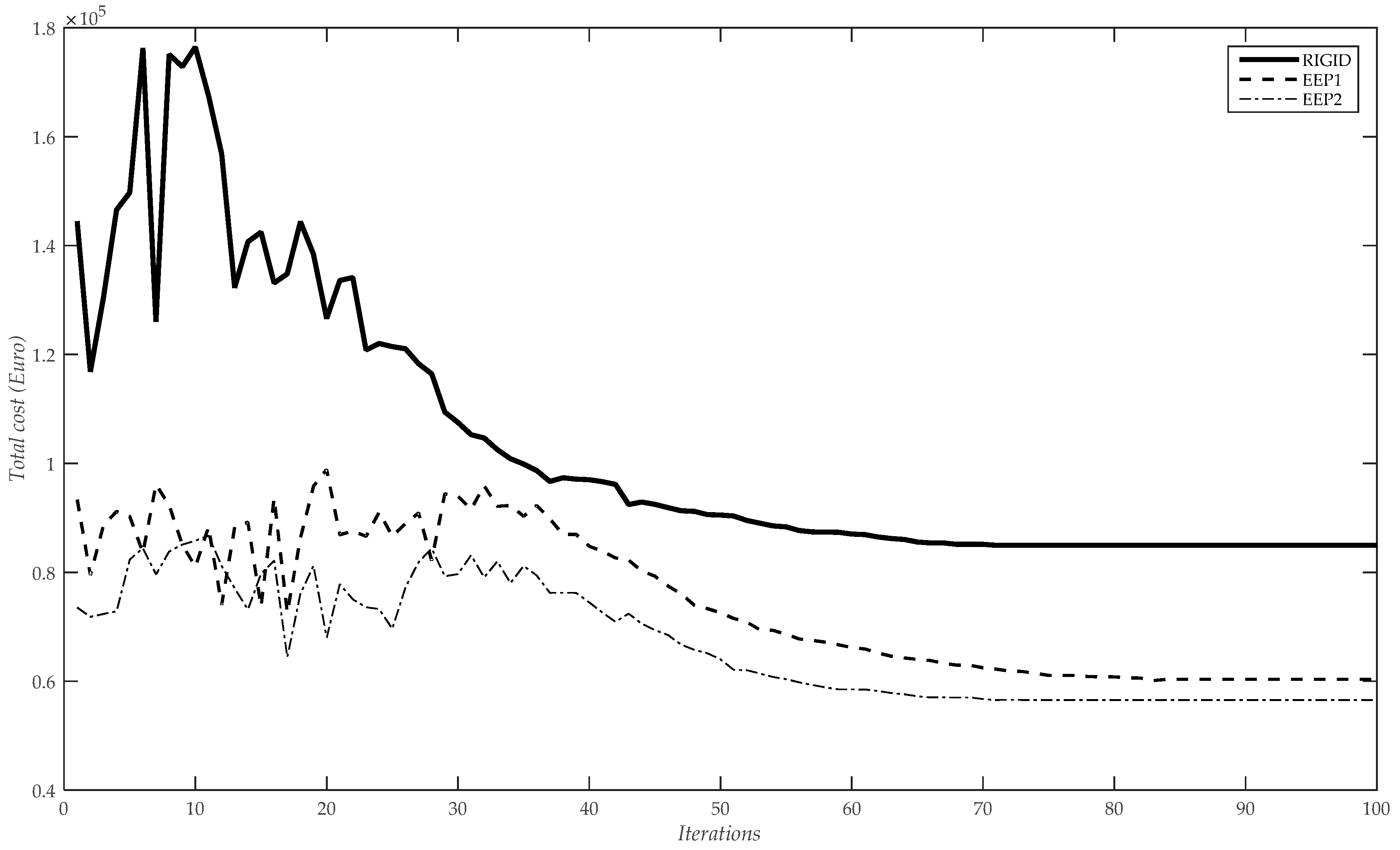
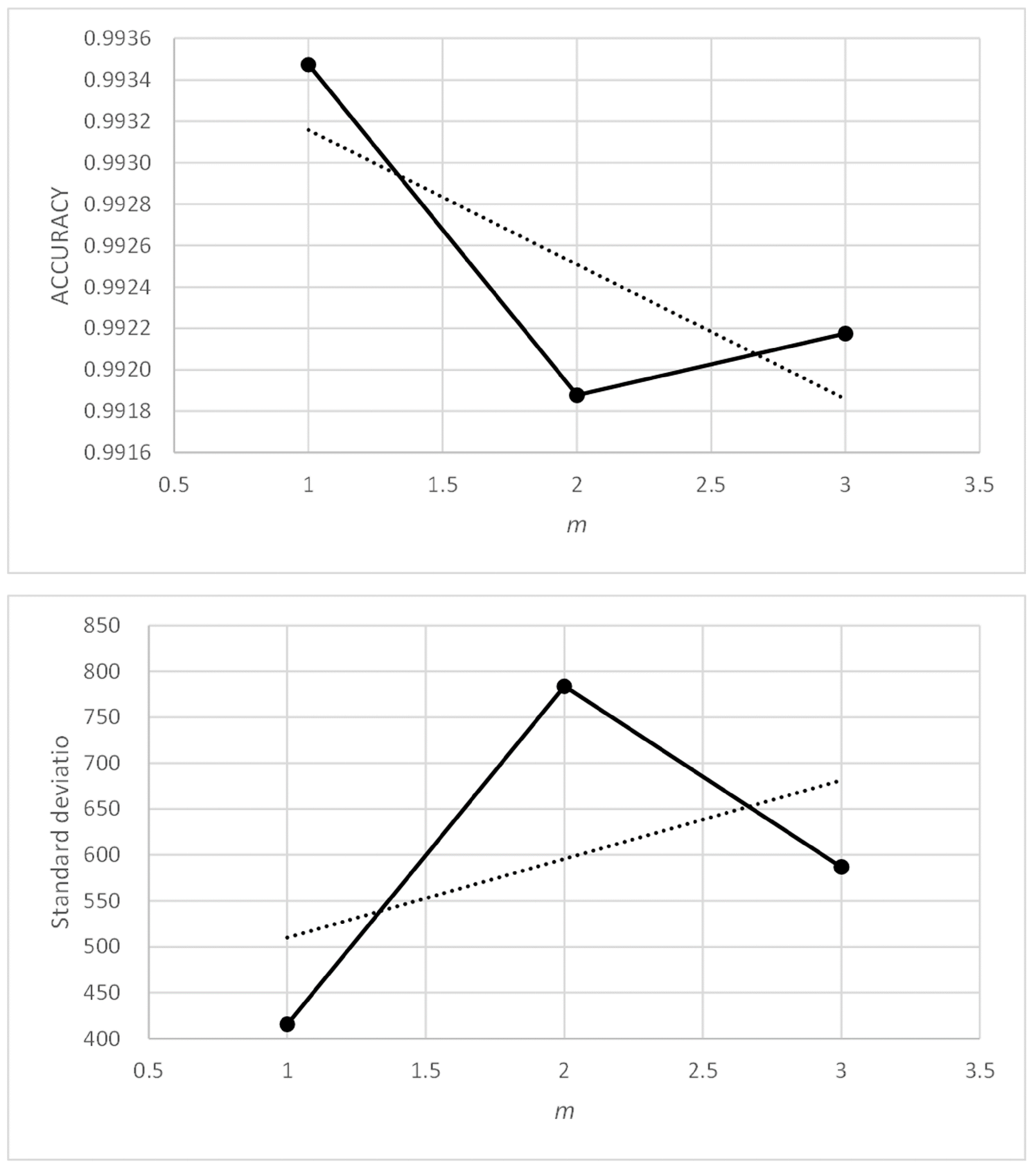
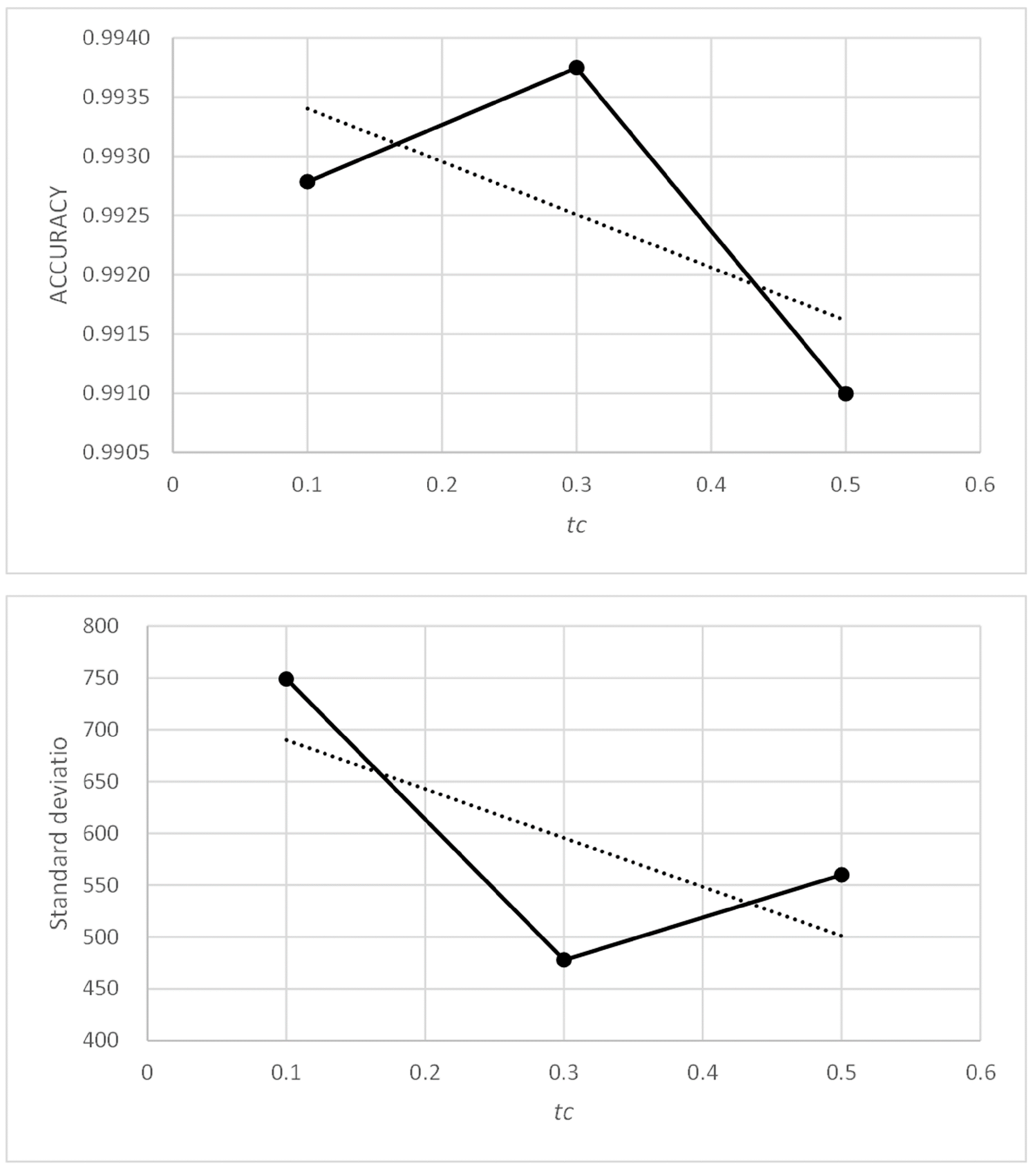
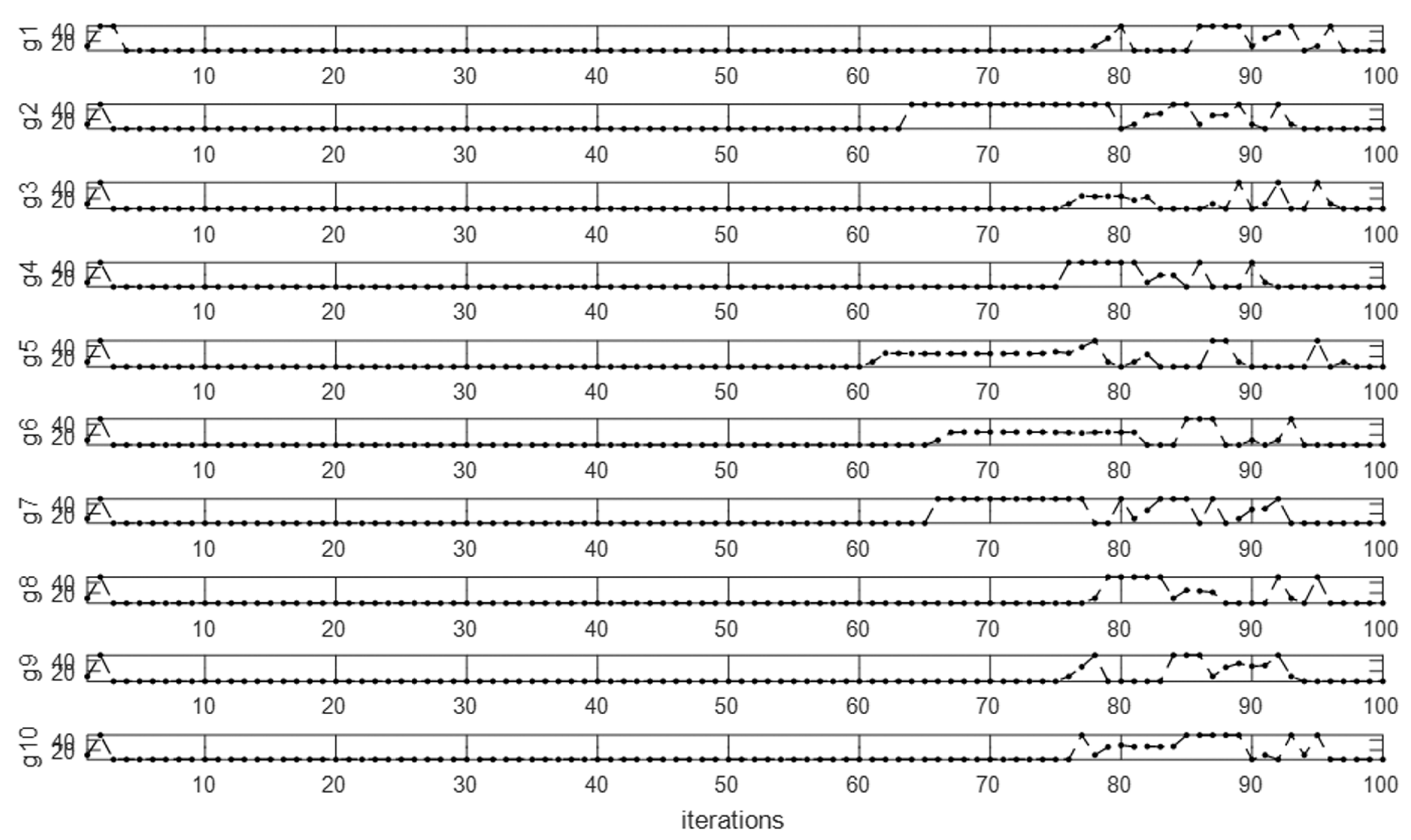
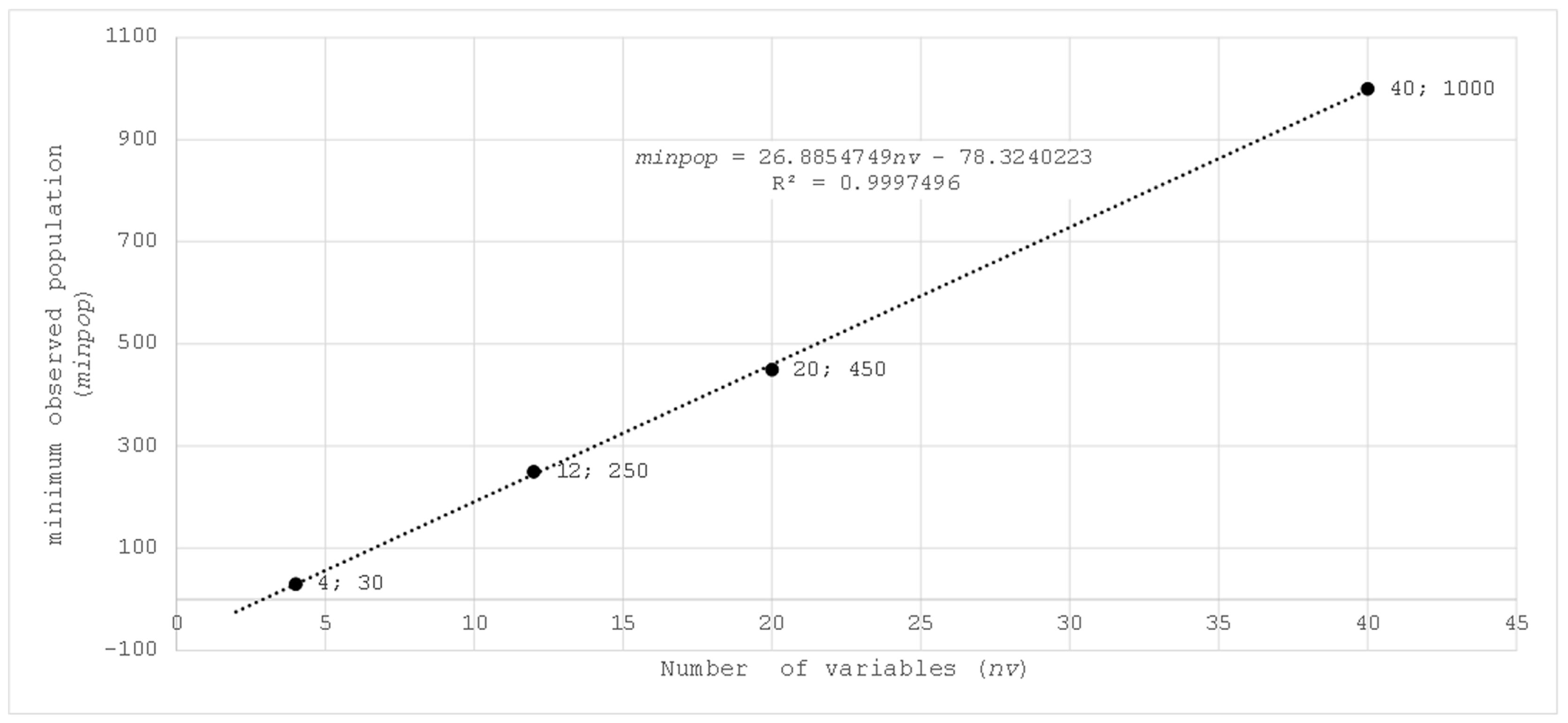
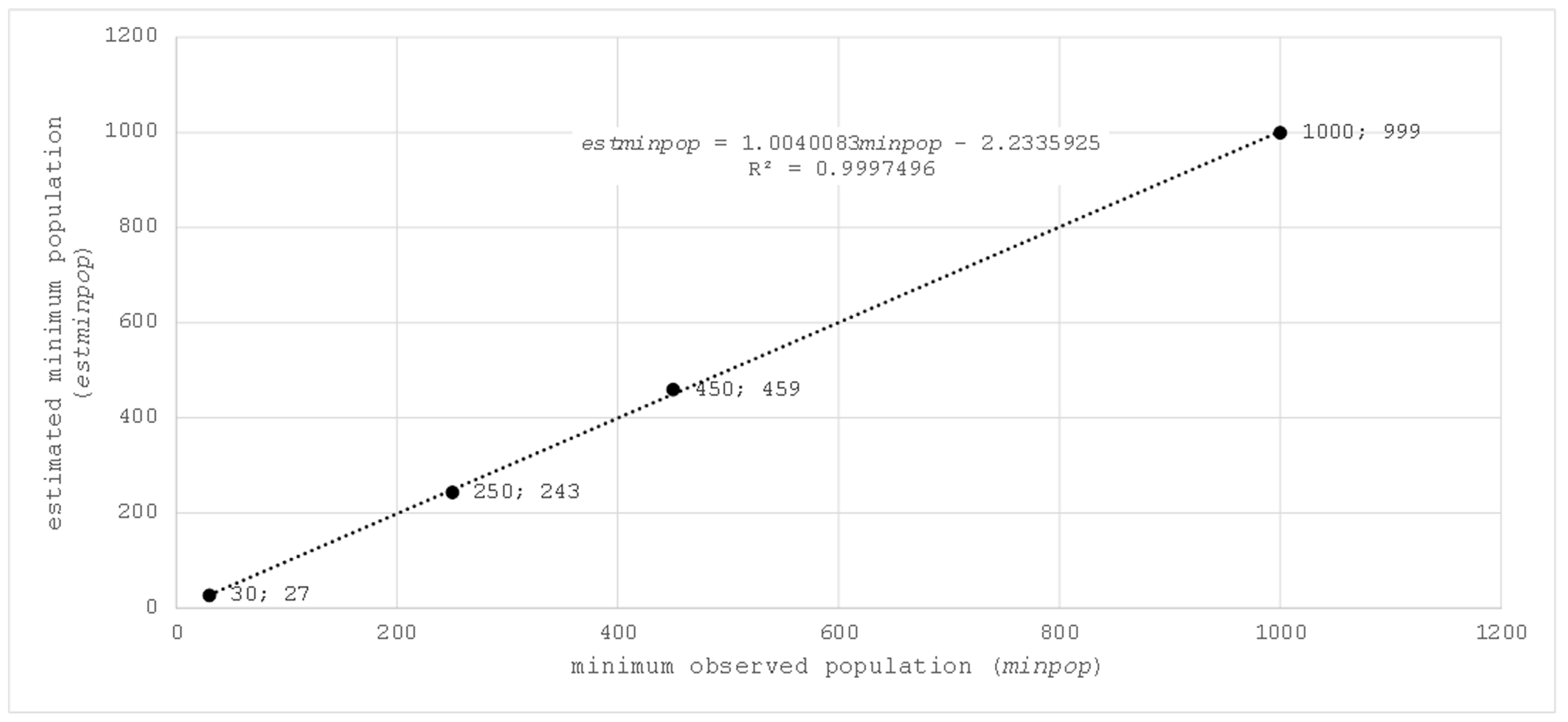
| Algorithm | Parameters | ||||||
|---|---|---|---|---|---|---|---|
| FA | β0 | m | γ | α | nt | kmax | |
| PFAM | β0 | m | γ0 | α0 | nt | kmax | tc |
| Members | Design Variable | Lower Bound | Upper Bound |
|---|---|---|---|
| columns | X1 (area), X2 (area) | 2.604 mm2 (HEB100) | 40.000 mm2 (HEB1000) |
| beams | X3 (area), X4 (area) | 764 mm2 (IPE80) | 15.600 mm2 (IPE600) |
| beams | X5 (db), X7 (db), X9 (db), X11 (db) | 10 mm | 36 mm |
| beams | X6 (tep), X8 (tep), X10 (tep), X12 (tep) | 8 mm | 25 mm |
| db = bolt diameter; tep = end-plate thickness | |||
| Variable | Cabrero and Bayo [32] | Ali et al. [33] | PFAM | |||||
|---|---|---|---|---|---|---|---|---|
| Rigid | Semi-rigid | Pinned | EEP1 | EEP2 | Rigid | EEP1 | EEP2 | |
| X1 | HEB140 | HEB140 | HEB120 | HEB140 | HEB140 | HEB180 | HEB120 | HEB120 |
| X2 | HEB160 | HEB160 | HEB140 | HEB140 | HEB140 | HEB140 | HEB160 | HEB160 |
| X3 | IPE270 | IPE270 | IPE330 | IPE240 | IPE240 | IPE240 | IPE300 | IPE300 |
| X4 | IPE200 | IPE200 | IPE240 | IPE200 | IPE180 | IPE180 | IPE240 | IPE240 |
| X5 (db) | - | 22 | - | - | 16 | 16 | ||
| X6 (tep) | - | 15 | - | - | 8 | 15 | ||
| X7 (db) | - | 22 | - | - | 20 | 20 | ||
| X8 (tep) | - | 14 | - | - | 15 | 12 | ||
| X9 (db) | - | 20 | - | - | 12 | 10 | ||
| X10 (tep) | - | 10 | - | - | 12 | 8 | ||
| X11 (db) | - | 16 | - | - | 16 | 16 | ||
| X12 (tep) | - | 12 | - | - | 10 | 10 | ||
| Total cost (EUR) | 5440.9 | 4124.6 | 4545.4 | 8434.2 | 6878.6 | 6202.3 | 5841.2 | 4804.8 |
| (132%) | (100%) | (110%) | (123%) | (100%) | (129%) | (122%) | (100%) | |
| kmax | |||||||||||
|---|---|---|---|---|---|---|---|---|---|---|---|
| 100 | 200 | 300 | 400 | 500 | 600 | 700 | 800 | 900 | 1000 | ||
| nt | 50 | 0.981796 | 0.990914 | 0.990803 | 0.997039 | 0.997004 | 0.999103 | 0.998948 | 0.999067 | 0.999034 | 0.998969 |
| 100 | 0.999115 | 0.999042 | 0.999084 | 0.999165 | 0.999109 | 0.998943 | 0.999144 | 0.999165 | 0.999358 | 0.999089 | |
| 150 | 0.999397 | 0.998991 | 0.999293 | 0.999117 | 0.999282 | 0.999038 | 0.999264 | 0.999216 | 0.999222 | 0.999495 | |
| 200 | 0.999395 | 0.999179 | 0.999267 | 0.999370 | 0.999269 | 0.999276 | 0.999370 | 0.999211 | 0.999275 | 0.999354 | |
| 250 | 0.999448 | 0.999395 | 0.999275 | 0.999203 | 0.999431 | 0.999379 | 0.999275 | 0.999249 | 0.999325 | 0.999213 | |
| 300 | 0.999280 | 0.999265 | 0.999174 | 0.999227 | 0.999295 | 0.999218 | 0.999327 | 0.999195 | 0.999250 | 0.999414 | |
| kmax | |||||||||||
|---|---|---|---|---|---|---|---|---|---|---|---|
| 100 | 200 | 300 | 400 | 500 | 600 | 700 | 800 | 900 | 1000 | ||
| nt | 50 | 156.87 | 78.49 | 67.06 | 42.47 | 42.42 | 1.82 | 1.68 | 1.56 | 1.84 | 1.64 |
| 100 | 2.12 | 1.51 | 1.48 | 1.79 | 1.80 | 1.67 | 1.75 | 1.75 | 1.89 | 1.72 | |
| 150 | 1.91 | 1.38 | 1.83 | 2.09 | 2.08 | 1.56 | 2.13 | 1.84 | 1.58 | 2.36 | |
| 200 | 1.34 | 1.46 | 1.85 | 1.80 | 1.88 | 1.72 | 1.82 | 1.88 | 1.68 | 2.31 | |
| 250 | 1.89 | 2.01 | 1.93 | 1.80 | 1.86 | 1.78 | 1.71 | 1.79 | 1.94 | 2.24 | |
| 300 | 1.98 | 2.07 | 1.47 | 2.06 | 1.55 | 2.19 | 1.90 | 1.67 | 1.87 | 1.44 | |
| m | ||||||
|---|---|---|---|---|---|---|
| 0.1 | 1 | 2 | 3 | 4 | ||
| tc | 0.1 | 0.999225 | 0.999392 | 0.999354 | 0.999191 | 0.999156 |
| 0.3 | 0.999084 | 0.999235 | 0.999058 | 0.999128 | 0.999107 | |
| 0.5 | 0.999025 | 0.999019 | 0.999127 | 0.999075 | 0.999005 | |
| 0.7 | 0.997381 | 0.996625 | 0.997035 | 0.995176 | 0.991253 | |
| 0.9 | 0.861724 | 0.910561 | 0.925047 | 0.975938 | 0.994787 | |
| m | ||||||
|---|---|---|---|---|---|---|
| 0.1 | 1 | 2 | 3 | 4 | ||
| tc | 0.1 | 1.28 | 1.44 | 1.42 | 2.09 | 1.81 |
| 0.3 | 1.55 | 1.97 | 1.39 | 2.19 | 1.50 | |
| 0.5 | 1.61 | 1.96 | 1.62 | 2.39 | 2.65 | |
| 0.7 | 33.54 | 30.80 | 40.10 | 57.53 | 77.53 | |
| 0.9 | 266.93 | 245.71 | 161.07 | 119.86 | 51.44 | |
| γ0 | ||||||
|---|---|---|---|---|---|---|
| 0.01 | 0.1 | 1 | 10 | 100 | ||
| α0 | 0.3 | 0.986493 | 0.982331 | 0.995845 | 0.999307 | 0.999308 |
| 0.4 | 0.985612 | 0.983652 | 0.991808 | 0.999444 | 0.999239 | |
| 0.5 | 0.979556 | 0.991716 | 0.999222 | 0.999210 | 0.999225 | |
| 0.6 | 0.976846 | 0.988560 | 0.999291 | 0.999396 | 0.999380 | |
| 0.7 | 0.986101 | 0.993526 | 0.999215 | 0.999200 | 0.999343 | |
| 0.8 | 0.995233 | 0.989365 | 0.999282 | 0.999277 | 0.999291 | |
| 0.9 | 0.987816 | 0.993768 | 0.999153 | 0.999281 | 0.999218 | |
| 1.0 | 0.982179 | 0.997174 | 0.999199 | 0.999186 | 0.999426 | |
| γ0 | ||||||
|---|---|---|---|---|---|---|
| 0.01 | 0.1 | 1 | 10 | 100 | ||
| α0 | 0.3 | 101.94 | 111.36 | 51.51 | 2.05 | 2.00 |
| 0.4 | 110.38 | 112.20 | 73.18 | 1.71 | 1.79 | |
| 0.5 | 160.42 | 89.93 | 1.97 | 1.64 | 2.11 | |
| 0.6 | 132.91 | 101.12 | 2.33 | 1.78 | 1.91 | |
| 0.7 | 130.83 | 64.21 | 2.01 | 1.44 | 1.75 | |
| 0.8 | 56.41 | 84.66 | 1.80 | 1.47 | 1.65 | |
| 0.9 | 85.31 | 65.29 | 1.84 | 1.54 | 2.01 | |
| 1.0 | 128.09 | 42.95 | 1.85 | 1.60 | 1.44 | |
| Number of Independent Runs | Accuracy | Standard Deviation |
|---|---|---|
| 10 | 0.999274 | 1.39 |
| 20 | 0.999326 | 1.91 |
| 30 | 0.999280 | 1.37 |
| 40 | 0.999139 | 1.77 |
| 50 | 0.999263 | 1.55 |
| 60 | 0.999248 | 1.41 |
| 70 | 0.999234 | 1.97 |
| 80 | 0.999204 | 1.77 |
| 90 | 0.999263 | 1.69 |
| 100 | 0.999225 | 1.66 |
| γ0 | Mean | ||||||
|---|---|---|---|---|---|---|---|
| 1 | 26 | 51 | 76 | 101 | |||
| α0 | 0.3 | 0.996939 | 0.999256 | 0.999294 | 0.999330 | 0.999348 | 0.999307 |
| 0.4 | 0.997757 | 0.999354 | 0.999314 | 0.999322 | 0.999274 | 0.999316 | |
| 0.5 | 0.998507 | 0.999251 | 0.999334 | 0.999361 | 0.999267 | 0.999303 | |
| 0.6 | 0.998454 | 0.999238 | 0.999315 | 0.999303 | 0.999261 | 0.999279 | |
| 0.7 | 0.999295 | 0.999246 | 0.999285 | 0.999346 | 0.999270 | 0.999287 | |
| 0.8 | 0.999253 | 0.999226 | 0.999315 | 0.999302 | 0.999335 | 0.999295 | |
| 0.9 | 0.999262 | 0.999278 | 0.999283 | 0.999333 | 0.999336 | 0.999308 | |
| 1.0 | 0.999244 | 0.999220 | 0.999310 | 0.999303 | 0.999338 | 0.999293 | |
| mean | 0.998589 | 0.999259 | 0.999306 | 0.999325 | 0.999304 | ||
| γ0 | Mean | ||||||
|---|---|---|---|---|---|---|---|
| 1 | 26 | 51 | 76 | 101 | |||
| α0 | 0.3 | 43.83 | 1.69 | 1.65 | 1.68 | 1.86 | 1.72 |
| 0.4 | 34.53 | 1.79 | 1.63 | 1.89 | 1.97 | 1.82 | |
| 0.5 | 25.59 | 1.67 | 1.76 | 1.83 | 1.77 | 1.76 | |
| 0.6 | 25.90 | 1.71 | 1.57 | 1.82 | 1.84 | 1.73 | |
| 0.7 | 2.06 | 1.68 | 1.84 | 1.87 | 1.82 | 1.80 | |
| 0.8 | 1.75 | 1.73 | 1.44 | 1.97 | 1.86 | 1.75 | |
| 0.9 | 1.96 | 1.59 | 1.61 | 1.68 | 1.79 | 1.67 | |
| 1.0 | 1.81 | 1.88 | 1.63 | 1.89 | 1.73 | 1.78 | |
| mean | 17.18 | 1.72 | 1.64 | 1.83 | 1.83 | ||
| m | ||||||
|---|---|---|---|---|---|---|
| 0.1 | 1 | 2 | 3 | 4 | ||
| tc | 0.1 | 0.999232 | 0.999384 | 0.999448 | 0.998102 | 0.995946 |
| 0.3 | 0.999262 | 0.999339 | 0.998328 | 0.998743 | 0.998043 | |
| 0.5 | 0.997609 | 0.997444 | 0.999372 | 0.998379 | 0.999071 | |
| 0.7 | 0.978781 | 0.979813 | 0.991873 | 0.997080 | 0.998367 | |
| 0.9 | 0.887117 | 0.896482 | 0.914793 | 0.982355 | 0.999070 | |
| m | ||||||
|---|---|---|---|---|---|---|
| 0.1 | 1 | 2 | 3 | 4 | ||
| tc | 0.1 | 1.82 | 1.94 | 2.12 | 31.45 | 58.40 |
| 0.3 | 1.79 | 1.80 | 40.93 | 23.67 | 31.90 | |
| 0.5 | 33.30 | 57.67 | 41.78 | 28.40 | 15.16 | |
| 0.7 | 152.44 | 133.41 | 89.46 | 40.12 | 30.48 | |
| 0.9 | 299.68 | 292.25 | 279.46 | 135.48 | 18.96 | |
| Parameter | β0 | tc | α0 | γ0 | m | nt | kmax |
|---|---|---|---|---|---|---|---|
| Values | 1 | [0.1, 0.3] | [0.3, 1.0] | [10, 100] | [1, 2] | 250 | 100 |
| kmax | |||||
|---|---|---|---|---|---|
| 100 | 200 | 300 | 400 | ||
| nt | 20 | 0.285222 | 0.247785 | 0.261767 | 0.259278 |
| 30 | 1.000000 | 0.963353 | 1.000000 | 1.000000 | |
| 40 | 0.973976 | 0.981145 | 0.974113 | 0.958629 | |
| 50 | 0.978822 | 0.973921 | 0.900450 | 0.977659 | |
| 60 | 1.000000 | 1.000000 | 0.903428 | 1.000000 | |
| 70 | 1.000000 | 1.000000 | 0.978588 | 0.975847 | |
| kmax | |||||
|---|---|---|---|---|---|
| 100 | 200 | 300 | 400 | ||
| nt | 20 | 7397.80 | 8252.30 | 7543.02 | 8751.77 |
| 30 | 0.00 | 1055.17 | 0.00 | 0.00 | |
| 40 | 741.13 | 533.04 | 737.13 | 1197.06 | |
| 50 | 600.14 | 742.73 | 1770.93 | 633.85 | |
| 60 | 0.00 | 0.00 | 1848.24 | 0.00 | |
| 70 | 0.00 | 0.00 | 606.91 | 473.55 | |
| m | Mean | ||||||
|---|---|---|---|---|---|---|---|
| 0.1 | 1 | 2 | 3 | 4 | |||
| tc | 0.1 | 0.939981 | 0.952263 | 0.907926 | 0.906337 | 0.997757 | 0.940853 |
| 0.3 | 0.892027 | 0.952263 | 1.000000 | 1.000000 | 0.972434 | 0.963345 | |
| 0.5 | 0.991727 | 0.968677 | 0.991667 | 0.949523 | 0.865564 | 0.953432 | |
| 0.7 | 0.849647 | 0.989311 | 0.962938 | 0.930684 | 0.935820 | 0.933680 | |
| 0.9 | 0.773004 | 0.783040 | 0.802276 | 0.852616 | 0.928368 | 0.827861 | |
| mean | 0.889277 | 0.929111 | 0.932961 | 0.927832 | 0.939988 | ||
| m | Mean | ||||||
|---|---|---|---|---|---|---|---|
| 0.1 | 1 | 2 | 3 | 4 | |||
| tc | 0.1 | 1706.55 | 1326.28 | 2747.97 | 1933.51 | 62.20 | 1555.30 |
| 0.3 | 3168.78 | 3407.01 | 0.00 | 0.00 | 672.47 | 1449.65 | |
| 0.5 | 106.54 | 896.74 | 107.80 | 1357.73 | 2315.51 | 956.86 | |
| 0.7 | 2880.12 | 119.48 | 813.47 | 1813.61 | 1268.89 | 1379.11 | |
| 0.9 | 2499.57 | 2696.02 | 2340.14 | 2202.24 | 405.41 | 2028.68 | |
| mean | 2072.31 | 1689.11 | 1201.87 | 1461.42 | 944.90 | ||
| γ0 | Mean | ||||||||
|---|---|---|---|---|---|---|---|---|---|
| 0.1 | 1 | 10 | 25 | 50 | 75 | 100 | |||
| α0 | 0.3 | 0.959600 | 0.997763 | 1.000000 | 0.981479 | 0.882398 | 0.985085 | 0.965603 | 0.967418 |
| 0.4 | 0.900188 | 0.952283 | 0.893250 | 0.944367 | 0.916266 | 0.896737 | 0.878108 | 0.911600 | |
| 0.5 | 0.967273 | 0.935148 | 0.995535 | 1.000000 | 0.944180 | 0.963209 | 0.901178 | 0.958075 | |
| 0.6 | 0.866837 | 0.900200 | 0.852008 | 0.973318 | 0.917225 | 0.929504 | 0.927877 | 0.909567 | |
| 0.7 | 0.953037 | 0.971434 | 0.997763 | 0.995754 | 0.808664 | 0.774844 | 0.813296 | 0.902113 | |
| 0.8 | 0.939030 | 0.997763 | 0.980223 | 0.959263 | 0.867033 | 0.866746 | 0.877740 | 0.926828 | |
| 0.9 | 0.931758 | 0.974162 | 0.843241 | 0.921092 | 0.948576 | 0.834133 | 0.828258 | 0.897317 | |
| 1.0 | 1.000000 | 0.958216 | 0.995945 | 0.831920 | 0.935031 | 0.826498 | 0.885162 | 0.918967 | |
| mean | 0.939715 | 0.960871 | 0.944746 | 0.950899 | 0.902422 | 0.884594 | 0.884653 | ||
| γ0 | Mean | ||||||||
|---|---|---|---|---|---|---|---|---|---|
| 0.1 | 1 | 10 | 25 | 50 | 75 | 100 | |||
| α0 | 0.3 | 1167.79 | 62.20 | 0.00 | 362.37 | 2676.21 | 119.23 | 456.98 | 692.11 |
| 0.4 | 2183.26 | 1389.88 | 2287.82 | 1347.20 | 1618.20 | 2351.95 | 2448.71 | 1946.72 | |
| 0.5 | 875.22 | 1923.60 | 85.61 | 0.00 | 1467.76 | 454.00 | 1717.72 | 931.99 | |
| 0.6 | 4261.05 | 2170.59 | 3074.81 | 646.22 | 1542.44 | 1558.64 | 1775.64 | 2147.05 | |
| 0.7 | 1366.83 | 752.74 | 62.20 | 81.53 | 3724.06 | 3934.32 | 3824.41 | 1963.72 | |
| 0.8 | 1305.55 | 62.20 | 559.64 | 1061.93 | 2821.36 | 2937.13 | 2327.36 | 1582.17 | |
| 0.9 | 2031.52 | 673.09 | 3783.01 | 2022.11 | 1291.52 | 2975.81 | 3209.71 | 2283.82 | |
| 1.0 | 0.00 | 1045.56 | 78.17 | 3015.74 | 1637.17 | 4034.38 | 2069.16 | 1697.17 | |
| mean | 1648.90 | 1009.98 | 1241.41 | 1067.14 | 2097.34 | 2295.68 | 2228.71 | ||
| m | Mean | ||||||
|---|---|---|---|---|---|---|---|
| 0.1 | 1 | 2 | 3 | 4 | |||
| tc | 0.1 | 0.966977 | 0.997763 | 0.965874 | 0.997763 | 1.000000 | 0.985675 |
| 0.3 | 0.937299 | 1.000000 | 1.000000 | 0.971894 | 0.949063 | 0.971651 | |
| 0.5 | 0.997763 | 1.000000 | 1.000000 | 0.925724 | 1.000000 | 0.984697 | |
| 0.7 | 1.000000 | 0.957633 | 1.000000 | 0.944917 | 0.930939 | 0.966698 | |
| 0.9 | 1.000000 | 0.969958 | 0.973759 | 0.998333 | 1.000000 | 0.988410 | |
| mean | 0.980408 | 0.985071 | 0.987927 | 0.967726 | 0.976001 | ||
| m | Mean | ||||||
|---|---|---|---|---|---|---|---|
| 0.1 | 1 | 2 | 3 | 4 | |||
| tc | 0.1 | 947.27 | 62.20 | 859.38 | 62.20 | 0.00 | 386.21 |
| 0.3 | 1855.53 | 0.00 | 0.00 | 802.13 | 1488.70 | 829.27 | |
| 0.5 | 62.20 | 0.00 | 0.00 | 1531.86 | 0.00 | 318.81 | |
| 0.7 | 0.00 | 1227.17 | 0.00 | 1616.95 | 2057.68 | 980.36 | |
| 0.9 | 0.00 | 859.11 | 700.23 | 46.33 | 0.00 | 321.13 | |
| mean | 573.00 | 429.69 | 311.92 | 811.89 | 709.28 | ||
| Parameter | β0 | tc | α0 | γ0 | m | nt | kmax |
|---|---|---|---|---|---|---|---|
| Values | 1 | [0.1, 0.5] | [0.3, 0.5] | [0.1, 25] | [1, 4] | 30 | 100 |
| Parameter | β0 | tc | α0 | γ0 | m | nt | kmax |
|---|---|---|---|---|---|---|---|
| Values | 1 | [0.1, 0.3] | [0.3, 0.5] | [10, 25] | [1, 2] | 30, 250 | 100 |
| PCPFAM | |||
|---|---|---|---|
| EEP2 Semi-Rigid Connections | Rigid Connections | ||
| Accuracy | Standard Deviation | Accuracy | Standard Deviation |
| 0.999336 | 2.08 | 1.000000 | 0.00 |
| Members | Variable | Lower Bound | Upper Bound |
|---|---|---|---|
| columns | X1 (area) to X10 (area) | HEB100 | HEB1000 |
| beams | X11 (area) to X20 (area) | IPE80 | IPE600 |
| beams | X21 (db), X23 (db), X25 (db), X27 (db), X29 (db), X31 (db), X33 (db), X35 (db), X37 (db), X39 (db) | 10 mm | 36 mm |
| beams | X22 (tep), X24 (tep), X26 (tep), X28 (tep), X30 (tep), X32 (tep), X34 (tep), X36 (tep), X38 (tep), X40 (tep) | 8 mm | 25 mm |
| Variable | Ali et al. [33] | PFAM | |||
|---|---|---|---|---|---|
| EEP1 | EEP2 | Rigid | EEP1 | EEP2 | |
| X1 | HEB450 | HEB400 | HEB320 | HEB320 | HEB320 |
| X2 | HEB450 | HEB500 | HEB900 | HEB800 | HEB800 |
| X3 | HEB300 | HEB300 | HEB360 | HEB300 | HEB300 |
| X4 | HEB360 | HEB360 | HEB400 | HEB450 | HEB450 |
| X5 | HEB280 | HEB260 | HEB260 | HEB260 | HEB280 |
| X6 | HEB300 | HEB300 | HEB340 | HEB340 | HEB340 |
| X7 | HEB240 | HEB240 | HEB240 | HEB240 | HEB240 |
| X8 | HEB240 | HEB260 | HEB260 | HEB260 | HEB260 |
| X9 | HEB200 | HEB200 | HEB220 | HEB180 | HEB180 |
| X10 | HEB200 | HEB220 | HEB180 | HEB180 | HEB180 |
| X11 | IPE450 | IPE450 | IPE360 | IPE400 | IPE400 |
| X12 | IPE450 | IPE550 | IPE400 | IPE400 | IPE400 |
| X13 | IPE450 | IPE450 | IPE400 | IPE450 | IPE450 |
| X14 | IPE450 | IPE500 | IPE400 | IPE450 | IPE500 |
| X15 | IPE450 | IPE400 | IPE400 | IPE400 | IPE450 |
| X16 | IPE450 | IPE450 | IPE400 | IPE450 | IPE500 |
| X17 | IPE450 | IPE500 | IPE360 | IPE400 | IPE450 |
| X18 | IPE400 | IPE500 | IPE360 | IPE450 | IPE500 |
| X19 | IPE500 | IPE400 | IPE330 | IPE360 | IPE400 |
| X20 | IPE400 | IPE330 | IPE270 | IPE300 | IPE300 |
| X21 (db) | - | 22 | 24 | ||
| X22 (tep) | - | 25 | 25 | ||
| X23 (db) | - | 24 | 24 | ||
| X24 (tep) | - | 25 | 25 | ||
| X25 (db) | - | 24 | 24 | ||
| X26 (tep) | - | 25 | 25 | ||
| X27 (db) | - | 24 | 27 | ||
| X28 (tep) | - | 25 | 25 | ||
| X29 (db) | - | 24 | 24 | ||
| X30 (tep) | - | 25 | 25 | ||
| X31 (db) | - | 22 | 24 | ||
| X32 (tep) | - | 20 | 20 | ||
| X33 (db) | - | 22 | 20 | ||
| X34 (tep) | - | 20 | 20 | ||
| X35 (db) | - | 22 | 20 | ||
| X36 (tep) | - | 15 | 12 | ||
| X37 (db) | - | 22 | 20 | ||
| X38 (tep) | - | 20 | 15 | ||
| X39 (db) | - | 16 | 20 | ||
| X40 (tep) | - | 15 | 12 | ||
| Total cost (EUR) | 107,314.3 (113%) | 95,193.1 (100%) | 84,904.3 (153%) | 59,864.4 (108%) | 55,630.2 (100%) |
| kmax | ||||
|---|---|---|---|---|
| 100 | 200 | 300 | ||
| nt | 500 | 0.970802 | 0.985971 | 0.988744 |
| 600 | 0.983134 | 0.986557 | 0.991328 | |
| 700 | 0.989667 | 0.988853 | 0.991794 | |
| 800 | 0.983148 | 0.986735 | 0.991775 | |
| 900 | 0.985811 | 0.991861 | 0.993167 | |
| 1000 | 0.989935 | 0.990955 | 0.990948 | |
| kmax | ||||
|---|---|---|---|---|
| 100 | 200 | 300 | ||
| nt | 500 | 901.14 | 667.36 | 339.27 |
| 600 | 610.27 | 326.69 | 120.05 | |
| 700 | 173.28 | 183.04 | 141.15 | |
| 800 | 739.94 | 189.09 | 243.24 | |
| 900 | 234.04 | 141.30 | 265.04 | |
| 1000 | 154.01 | 273.08 | 274.00 | |
| m | Mean | ||||
|---|---|---|---|---|---|
| 1 | 2 | 3 | |||
| tc | 0.1 | 0.988397 | 0.987065 | 0.967465 | 0.980976 |
| 0.3 | 0.987863 | 0.975870 | 0.955743 | 0.973159 | |
| 0.5 | 0.974107 | 0.964007 | 0.951925 | 0.963346 | |
| mean | 0.9835 | 0.9756 | 0.9584 | ||
| m | Mean | ||||
|---|---|---|---|---|---|
| 1 | 2 | 3 | |||
| tc | 0.1 | 275.28 | 213.71 | 1498.46 | 662.49 |
| 0.3 | 326.75 | 1018.38 | 1162.37 | 835.83 | |
| 0.5 | 674.17 | 1015.90 | 1019.74 | 903.27 | |
| mean | 425.40 | 749.33 | 1226.86 | ||
| γ0 | Mean | |||||
|---|---|---|---|---|---|---|
| 0.1 | 1 | 10 | 25 | |||
| α0 | 0.3 | 0.968874 | 0.977775 | 0.994244 | 0.988987 | 0.982470 |
| 0.4 | 0.944331 | 0.980527 | 0.993107 | 0.993071 | 0.977759 | |
| 0.5 | 0.968911 | 0.982921 | 0.993255 | 0.992099 | 0.984297 | |
| 0.6 | 0.949196 | 0.979579 | 0.990534 | 0.992214 | 0.977881 | |
| 0.7 | 0.909226 | 0.986223 | 0.990505 | 0.989142 | 0.968774 | |
| 0.8 | 0.909226 | 0.983006 | 0.987852 | 0.987241 | 0.966831 | |
| 0.9 | 0.966962 | 0.983008 | 0.989730 | 0.984751 | 0.981113 | |
| 1.0 | 0.969974 | 0.982574 | 0.986272 | 0.988684 | 0.981876 | |
| mean | 0.948337 | 0.981952 | 0.990688 | 0.989524 | ||
| γ0 | Mean | |||||
|---|---|---|---|---|---|---|
| 0.1 | 1 | 10 | 25 | |||
| α0 | 0.3 | 695.53 | 1006.48 | 51.63 | 578.95 | 583.15 |
| 0.4 | 5032.57 | 801.17 | 176.01 | 185.58 | 1548.83 | |
| 0.5 | 1127.87 | 470.94 | 186.29 | 176.27 | 490.34 | |
| 0.6 | 3371.61 | 693.22 | 121.17 | 273.67 | 1114.92 | |
| 0.7 | 8076.86 | 285.18 | 151.78 | 196.01 | 2177.46 | |
| 0.8 | 2910.99 | 876.56 | 666.37 | 792.41 | 1311.58 | |
| 0.9 | 1196.02 | 1019.10 | 258.01 | 716.03 | 797.29 | |
| 1.0 | 1076.03 | 352.63 | 669.74 | 116.06 | 553.62 | |
| mean | 2935.94 | 688.16 | 285.13 | 379.37 | ||
| Parameter | β0 | tc | α0 | γ0 | m | nt | kmax |
|---|---|---|---|---|---|---|---|
| Values | 1 | [0.1, 0.3] | [0.3, 1.0] | [10,25] | [1, 2] | 1000 | 100 |
| kmax | ||||
|---|---|---|---|---|
| 100 | 200 | 300 | ||
| nt | 250 | 0.991133 | 0.994741 | 0.993758 |
| 350 | 0.990264 | 0.993835 | 0.991943 | |
| 450 | 0.995536 | 0.993890 | 0.995469 | |
| 550 | 0.995994 | 0.997256 | 0.996817 | |
| 650 | 0.995159 | 0.994355 | 0.996200 | |
| 750 | 0.995524 | 0.996871 | 0.997500 | |
| kmax | ||||
|---|---|---|---|---|
| 100 | 200 | 300 | ||
| nt | 250 | 1062.06 | 418.96 | 464.40 |
| 350 | 855.65 | 482.26 | 730.82 | |
| 450 | 421.07 | 890.25 | 414.91 | |
| 550 | 358.55 | 248.38 | 227.97 | |
| 650 | 422.30 | 480.08 | 345.64 | |
| 750 | 466.57 | 219.60 | 256.73 | |
| m | Mean | ||||
|---|---|---|---|---|---|
| 1 | 2 | 3 | |||
| tc | 0.1 | 0.995677 | 0.988884 | 0.993793 | 0.992785 |
| 0.3 | 0.993986 | 0.995758 | 0.991494 | 0.993746 | |
| 0.5 | 0.990757 | 0.990991 | 0.991238 | 0.990996 | |
| mean | 0.993473 | 0.991878 | 0.992175 | ||
| m | Mean | ||||
|---|---|---|---|---|---|
| 1 | 2 | 3 | |||
| tc | 0.1 | 325.31 | 1225.13 | 696.53 | 748.99 |
| 0.3 | 478.43 | 429.79 | 525.33 | 477.85 | |
| 0.5 | 443.69 | 696.55 | 539.24 | 559.83 | |
| mean | 415.81 | 783.82 | 587.04 | ||
| γ0 | Mean | ||||||
|---|---|---|---|---|---|---|---|
| 0.1 | 1 | 10 | 25 | 50 | |||
| α0 | 0.3 | 0.993540 | 0.994849 | 0.997128 | 0.994266 | 0.991229 | 0.994202 |
| 0.4 | 0.995109 | 0.994394 | 0.996860 | 0.992294 | 0.992450 | 0.994221 | |
| 0.5 | 0.993989 | 0.995789 | 0.995578 | 0.993692 | 0.992928 | 0.994395 | |
| 0.6 | 0.993387 | 0.996551 | 0.996689 | 0.994053 | 0.991264 | 0.994389 | |
| mean | 0.994006 | 0.995396 | 0.996564 | 0.993576 | 0.991968 | ||
| γ0 | Mean | ||||||
|---|---|---|---|---|---|---|---|
| 0.1 | 1 | 10 | 25 | 50 | |||
| α0 | 0.3 | 633.18 | 526.82 | 272.53 | 404.81 | 675.01 | 502.47 |
| 0.4 | 680.30 | 478.73 | 252.84 | 607.21 | 453.03 | 494.42 | |
| 0.5 | 574.85 | 348.84 | 380.81 | 405.75 | 421.31 | 426.31 | |
| 0.6 | 810.14 | 98.94 | 125.15 | 400.91 | 396.91 | 366.41 | |
| mean | 674.62 | 363.33 | 257.83 | 454.67 | 486.57 | ||
| Parameter | β0 | tc | α0 | γ0 | m | nt | kmax |
|---|---|---|---|---|---|---|---|
| Values | 1 | [0.1, 0.5] | [0.3, 0.6] | [0.1, 50] | [1, 3] | 450 | 100 |
| Parameter | β0 | tc | α0 | γ0 | m | nt | kmax |
|---|---|---|---|---|---|---|---|
| Values | 1 | [0.1, 0.3] | [0.3, 0.6] | [10, 25] | [1, 2] | 450, 1000 | 100 |
| PCPFAM | |||
|---|---|---|---|
| EEP2 Semi-Rigid Connections | Rigid Connections | ||
| Accuracy | Standard Deviation | Accuracy | Standard Deviation |
| 0.992651 | 207.15 | 0.995769 | 389.17 |
| Case | TNPD | be |
|---|---|---|
| Three-bay two-story framework with rigid connections | (ne = 18) (nve = 2) ∙ (ne = 24) (nve = 2) = = 182 ∙ 242 = 186,624 ≈ 20.7846096914 = = (be = 20.784609691) (nve = 2+2) | 20.784609691 |
| Three-bay two-story framework with semi-rigid connections | 182 ∙ 242 ∙ 104 ∙ 124 = = 3.86983526 ∙ 1013 ≈ ≈ 13.56149931912 | 13.561499319 |
| Three-bay ten-story framework with rigid connections | 1810 ∙ 2410 = = 2.26379694 ∙ 1026 ≈ ≈ 20.78460969120 | 20.784609691 |
| Three-bay two-story framework with semi-rigid connections | 1810 ∙ 2410 ∙ 1010 ∙ 1210 = = 1.40168340 ∙ 1047 ≈ ≈ 15.08920115640 | 15.089201156 |
| Case | TNPD | log17.554979964(TNPD) | nv | Minpop |
|---|---|---|---|---|
| Three-bay two-story framework with rigid connections | 186,624 | 4.24 | 4 | 30 |
| Three-bay two-story framework with semi-rigid connections | 3.86983526 · 1013 | 10.92 | 12 | 250 |
| Three-bay ten-story framework with rigid connections | 2.26379694 ∙ 1026 | 21.18 | 20 | 450 |
| Three-bay two-story framework with semi-rigid connections | 1.40168340 ∙ 1047 | 37.89 | 40 | 1000 |
Disclaimer/Publisher’s Note: The statements, opinions and data contained in all publications are solely those of the individual author(s) and contributor(s) and not of MDPI and/or the editor(s). MDPI and/or the editor(s) disclaim responsibility for any injury to people or property resulting from any ideas, methods, instructions or products referred to in the content. |
© 2023 by the authors. Licensee MDPI, Basel, Switzerland. This article is an open access article distributed under the terms and conditions of the Creative Commons Attribution (CC BY) license (https://creativecommons.org/licenses/by/4.0/).
Share and Cite
Sánchez-Olivares, G.; Tomás, A.; García-Ayllón, S. A Minimum Cost Design Approach for Steel Frames Based on a Parallelized Firefly Algorithm and Parameter Control. Appl. Sci. 2023, 13, 11801. https://doi.org/10.3390/app132111801
Sánchez-Olivares G, Tomás A, García-Ayllón S. A Minimum Cost Design Approach for Steel Frames Based on a Parallelized Firefly Algorithm and Parameter Control. Applied Sciences. 2023; 13(21):11801. https://doi.org/10.3390/app132111801
Chicago/Turabian StyleSánchez-Olivares, Gregorio, Antonio Tomás, and Salvador García-Ayllón. 2023. "A Minimum Cost Design Approach for Steel Frames Based on a Parallelized Firefly Algorithm and Parameter Control" Applied Sciences 13, no. 21: 11801. https://doi.org/10.3390/app132111801
APA StyleSánchez-Olivares, G., Tomás, A., & García-Ayllón, S. (2023). A Minimum Cost Design Approach for Steel Frames Based on a Parallelized Firefly Algorithm and Parameter Control. Applied Sciences, 13(21), 11801. https://doi.org/10.3390/app132111801








